Now that the deadline for candidates to qualify for the June primary ballot has passed, it’s time to revisit the 2020 Iowa House landscape. (A separate overview of state Senate races is in progress.)
Republicans now hold a 53-47 majority in the lower chamber, meaning Democrats need a net gain of four seats for control. Thanks to our state’s nonpartisan redistricting system, more than a dozen House districts should be highly competitive. This post covers 22 House districts that could fall into that category. One or both parties spent significant funds on twenty Iowa House races in 2018, not counting House districts 82 or 16, where Republican candidates ended up winning by small margins.
Since Bleeding Heartland first reviewed the House landscape last May, both parties have had some recruiting successes, while other districts still lack a top-tier challenger. The Secretary of State published the full list of Democratic and GOP primary candidates here. In some races that are currently uncontested, major parties may get candidates on the ballot later by holding a special nominating convention.
All voter registration totals listed below come from the Iowa Secretary of State’s office, as reported on March 2. Those numbers include party-switchers who became Democrats in order to participate in the Iowa caucuses.
Figures on voting for president in 2016 and for governor in 2018 in each House district come from this spreadsheet compiled by the Daily Kos Elections team.
Note: Charles Nuttycombe, who monitors state legislative races across the country, considers the battle for control of the Iowa House a toss-up.
TOP DEMOCRATIC TARGETS
Though reasonable minds can differ about which seats held by each party are vulnerable, I see three House districts as the most promising targets for Democrats this November. Two of them will be rematches from 2018.
House district 55
State Representative Michael Bergan received nine more votes than Kayla Koether last cycle, according to the certified results. His victory should forever be marked with an asterisk. Republicans used their House majority to ensure that 29 absentee ballots would never be counted, even though Winneshiek County voters had mailed them on time.
Since the last election, Bergan got some bad publicity related to a board on which he has long served. The Associated Press reported in September 2019 that the Iowa Communities Assurance Pool routinely held its “public meetings” at luxury out-of-state resorts. Bergan never responded to my follow-up questions related to that story.
Bergan was widely seen as likely to run for Iowa Senate district 28, where Republican Senator Michael Breitbach is retiring. However, he opted to run for re-election instead.
Local Democrats are enthusiastic about Koether, who confirmed her candidacy in February. The GOP voter registration advantage in the district has shrunk since November 2018. Koether didn’t endorse a presidential candidate before the Iowa caucuses. There was no clear winner across the precincts in House district 55.
During the months leading up to the 2018 election, Democrats spent nearly $125,000 supporting Koether, while Republicans spent about $168,000 supporting Bergan. I expect both parties to spend more here this fall.
Latest active registered voter totals: 5,932 Democrats, 6,190 Republicans, 6,771 no-party voters
2016 voting for president: Donald Trump 50.6 percent, Hillary Clinton 43.5 percent
2018 voting for governor: Kim Reynolds 50.7 percent, Fred Hubbell 46.0 percent
Michael Bergan: Facebook
Kayla Koether: website, Facebook, Twitter
House district 67
Even before State Representative Ashley Hinson confirmed she would run for Congress in 2020, this district in the Cedar Rapids looked like a great opportunity for Democrats. Hinson easily won her first state House race in 2016 but was re-elected by only 52.0 percent to 48.0 percent for Eric Gjerde in 2018. She is the only House Republican representing a district that voted for Hubbell.
Hinson launched her Congressional campaign in May 2019, and Gjerde confirmed last July that he would run in House district 67 again. Oddly, Republicans didn’t have a declared candidate until shortly before the March 13 filing deadline.
I wondered whether Linn County Republicans had some strategic reason for keeping their candidate secret here, but my guess is they had genuine recruiting trouble. Former Cedar Rapids City Council member Susie Weinacht changed her registration to Republican and filed nominating papers early last week, only to pull them two days later after Sally Ann Abbott filed for the GOP primary as well. I haven’t found a campaign website or Facebook page for Abbott, so it wasn’t a well-orchestrated rollout.
During the 2018 campaign, Democrats spent about $265,000 on behalf of Gjerde, while Republicans spent $172,000 supporting Hinson. This year’s race could be more expensive, or Republicans may spend less, for lack of an incumbent to protect. Last cycle, the GOP in effect conceded Iowa House districts 43 and 68, both seats in suburban areas where incumbents were not seeking re-election.
Another relevant data point: thanks in part to strong Iowa caucus turnout in Linn County, Democrats now have a voter registration advantage in House district 67, for the first time this decade.
Gjerde didn’t endorse a presidential candidate before the Iowa caucuses. The precincts in this district didn’t clearly favor any one candidate; in most of them, two or more contenders tied.
Current active registered voter totals: 7,118 Democrats, 6,929 Republicans, 8,314 no-party voters
2016 voting for president: Trump 45.7 percent, Clinton 47.2 percent
2018 voting for governor: Reynolds 47.3 percent, Hubbell 50.2 percent
Eric Gjerde: website, Facebook, Twitter
House district 82
This one was a heartbreaker. After State Representative Curt Hanson passed away in the summer of 2017, Democrats spent lots of money and mobilized many volunteers to help Phil Miller win the special election.
Neither party spent significant money here during the 2018 campaign. The young Republican candidate Jeff Shipley wasn’t seen as a threat; he had fallen short against Hanson in 2014, a GOP landslide year. But Shipley defeated Miller by 37 votes, 50.1 percent to 49.8 percent.
A veterinarian with ties throughout the district, Miller is strongly positioned for this year’s rematch. Democrats will not overlook this race again.
Shipley is an unconventional politician. He frequently uses his Twitter feed to do battle with what he calls “Pharma fascists” promoting vaccination. He has occasionally voted against the rest of the Republican caucus (most recently on an education funding bill) and in 2019 was the only House member to oppose a bill increasing transportation funding for rural school districts.
On the other hand, some of Shipley’s unusual stances will be popular in this district, which includes Fairfield. He was among the Republicans who kept MidAmerican’s bad solar bill from passing in 2019. Also last year, he proposed legalizing the use of the whole cannabis plant for medical purposes.
Miller didn’t endorse a presidential candidate before the Iowa caucuses. House district 82 contained some strong precincts for Bernie Sanders, Joe Biden, and Pete Buttigieg.
Current active registered voter totals: 6,528 Democrats, 6,273 Republicans, 5,690 no-party voters
2016 voting for president: Trump 57.8 percent, Clinton 36.5 percent
2018 voting for governor: Reynolds 54.4 percent, Hubbell 43.3 percent
Jeff Shipley: Facebook, Twitter
Phil Miller: website, Facebook
SECONDARY DEMOCRATIC TARGETS
House district 16
This was another race Democrats overlooked in 2018. The party spent hundreds of thousand of dollars in some House districts but almost nothing here beyond what challenger Steve Gorman raised himself. Then he came close to beating GOP State Representative Mary Ann Hanusa; she won by a 49.5 percent to 48.4 percent margin.
Gorman’s running for Iowa Senate district 8 this cycle. Democrats landed a strong candidate for this House race in Jen Pellant.
Hanusa announced last week that she will retire from the legislature. Under normal circumstances, that would greatly improve prospects for the party out of power. But former Iowa House Speaker Brent Siegrist, who long represented part of Council Bluffs, stepped in and became the sole GOP candidate to file for the primary. He has higher name recognition than most candidates running for open House or Senate seats.
Pellant worked on John Delaney’s presidential campaign last year. Several Democratic candidates had pockets of support in Council Bluffs, but Buttigieg carried more precincts than the others in the February 3 caucuses.
Speaking of presidential voting, a bit of trivia: House district 16 is one of only two Iowa House districts where voting for president in 2012 and 2016 closely matched Iowa’s statewide results. (The other bellwether was House district 95, discussed below.)
Current active registered voter totals: 5,211 Democrats, 5,631 Republicans, 6,239 no-party voters
2016 voting for president: Trump 51.8 percent, Clinton 41.8 percent
2018 voting for governor: Reynolds 49.8 percent, Hubbell 47.4 percent
Jen Pellant: website, Facebook, Twitter
House district 37
Bleeding Heartland recently previewed this race in detail. Some of my contacts believe it’s one of the best Democratic pickup opportunities, and I may move it up my list later this year.
When Democrat Andrea Phillips ran against State Representative John Landon in 2016, neither party spent much money on the race. The same was true in 2018, when Andrew Rasmussen was Landon’s challenger. But Ankeny is no exception to the political trends seen in suburbs across the country. Landon didn’t beat Rasmussen by much: 52.0 percent to 47.9 percent.
After Phillips announced last October that she would run for the state House again, she raised a lot of money for a House challenger. I thought Landon might retire, but he is sticking it out.
Republicans outnumbered Democrats by nearly 3,000 in November 2018. Now the GOP registration edge is only about 1,600. Trump may perform more poorly in Ankeny than he did in 2016.
Another point in Phillips’ favor: the Ankeny Area Democrats are among the best-organized local Democratic organizations in Iowa. More than 20 volunteers turned up for a recent planning meeting Phillips held. She will have a small army helping her with voter outreach.
Phillips didn’t endorse a presidential candidate before the Iowa caucuses. No Democrat dominated the precincts in this district.
Current active registered voter totals: 8,495 Democrats, 10,156 Republicans, 9,819 no-party voters
2016 voting for president: Trump 50.5 percent, Clinton 42.1 percent
2018 voting for governor: Reynolds 50.6 percent, Hubbell 47.5 percent
John Landon: Facebook
Andrea Phillips: website, Facebook, Twitter
House district 73
I wrote last spring, “State Representative Bobby Kaufmann is unlikely to be seriously threatened if he seeks re-election.” I revised that view after longtime Johnson County Sheriff Lonny Pulkrabek announced his candidacy here.
Bleeding Heartland will soon publish an in-depth analysis of this race. For now, I still see the incumbent favored. The Kaufmann name is a tremendous asset in Cedar County; Bobby Kaufmann’s father Jeff Kaufmann previously represented this area in the legislature and is now a county supervisor, as well as the state chair of the Republican Party of Iowa. The GOP will spare no expense needed to defend this seat.
That said, the Johnson County portion of this district is growing, and Pulkrabek will have plenty of eager volunteers.
Current active registered voter totals: 6,632 Democrats, 6,093 Republicans, 7,955 no-party voters
2016 voting for president: Trump 51.2 percent, Clinton 43.3 percent
2018 voting for governor: Reynolds 49.6 percent, Hubbell 48.3 percent
Bobby Kaufmann: Facebook
Lonny Pulkrabek: website, Facebook
House district 91
A Democrat hasn’t represented the Muscatine area in the Iowa House since 2010. This year will be the party’s best chance in a while to win the seat back. Bleeding Heartland previewed this race after Muscatine City Council member Kelcey Brackett announced his candidacy. Republican Gary Carlson later confirmed he will retire.
The new Republican candidate is Mark Cisneros, “a Mexican American small business owner in Muscatine.” The Muscatine area has a large Latino population. While Latino voters have favored Democrats in recent elections, Cisneros could make history by becoming Iowa’s first person of Hispanic heritage to serve in the state legislature.
The last battle for House district 91 was expensive by Iowa standards, as Republicans spent about $346,000 defending Carlson’s seat, while Democrats spent nearly $270,000 supporting challenger Laura Liegois. Depending on how the parties’ internal polling looks in the late summer, another costly campaign could be in the works.
Brackett did not endorse a presidential candidate before the Iowa caucuses, and no Democrat dominated the precincts in House district 91.
Current active registered voter totals: 5,834 Democrats, 5,627 Republicans, 7,323 no-party voters
2016 voting for president: Trump 49.8 percent, Clinton 43.7 percent
2018 voting for governor: Reynolds 50.5 percent, Hubbell 47.2 percent
Kelcey Brackett: website, Facebook, Twitter
House district 95
Bleeding Heartland profiled the Louis Zumbach/Christian Andrews rematch in December. Zumbach later opted not to seek a third term in the House.
Two Republicans are seeking the nomination: Phil High and Charlie McClintock. I haven’t found campaign websites or Facebook pages for either candidate yet.
The GOP spent about $225,000 defending this seat in 2018, far more than Democrats spent on behalf of Andrews. Zumbach won that race by 53.9 percent to 46.0 percent.
As an open seat, this district should be more winnable for Andrews, and I expect more than a token amount of Democratic spending here. Many Iowa lawmakers have lost their first race but been successful on their second attempt.
Current active registered voter totals: 6,546 Democrats, 6,356 Republicans, 8,606 no-party voters
2016 voting for president: Trump 51.6 percent, Clinton 41.9 percent
2018 voting for governor: Reynolds 50.9 percent, Hubbell 46.4 percent
Christian Andrews: website, Facebook, Twitter
MISSED DEMOCRATIC OPPORTUNITY?
House district 9
Republican Ann Meyer didn’t win this open-seat race by much, 51.7 percent to 48.2 percent for Megan Srinivas, even though the GOP heavily outspent Democrats on television advertising. But Meyer now has the advantages of incumbency, and her district voted for Trump by a large margin.
Srinivas decided against running for the Iowa House again, she told Bleeding Heartland last week. No Democrat filed for the seat before the March 13 deadline, so Meyer will be unopposed unless Democrats nominate someone later through a special convention. Iowa’s mid-sized cities like Fort Dodge have been trending away from the Democratic Party over the past decade, so recruiting a strong challenger may be difficult.
If a Democrat does run here, one sleeper issue could be Meyer’s last-minute decision in 2019 to vote for a bill that shortened the term of then Iowa Supreme Court Chief Justice Mark Cady, her constituent. The flip-flop didn’t get a lot of media coverage but angered many Fort Dodge residents who knew about it. Meyer had been telling local contacts that she opposed the judicial changes.
Current active registered voter totals: 6,058 Democrats, 5,155 Republicans, 6,904 no-party voters
2016 voting for president: Trump 55.3 percent, Clinton 39.3 percent
2018 voting for governor: Reynolds 52.1 percent, Hubbell 46.0 percent
TOP REPUBLICAN TARGETS
While House Republicans will be playing a lot of defense this fall, they also have a realistic chance to flip some Democratic-held seats, especially if the national political environment is more favorable to the GOP as the election approaches. My views on the best Republican prospects have changed a lot since last spring.
House district 29
Republicans didn’t invest in this race in 2018, and Democratic State Representative Wes Breckenridge won his second term by a comfortable margin of more than 2,000 votes. So I didn’t include this race in my first overview of the House landscape.
My impression is the GOP may put real money behind challenger Jon Dunwell, a former pastor who has worked in financial services in Newton and is now an “executive coach for businesses, non-profits, and churches.”
Breckenridge retired from the Newton Police Department in 2017 due to a recurring shoulder injury (a common hazard for law enforcement). He substantially outperformed the top of the Democratic ticket in both of his previous races. But given voting trends in mid-sized cities like Newton, Democrats should not take this seat for granted. Residents of House district 29 favored Barack Obama by double digits in 2012 but swung heavily to Trump four years ago.
Breckenridge didn’t endorse a presidential candidate before the Iowa caucuses. Buttigieg carried most Jasper County precincts.
Current active registered voter totals: 7,167 Democrats, 5,842 Republicans, 7,737 no-party voters
2016 voting for president: Trump 53.2 percent, Clinton 40.8 percent
2018 voting for governor: Reynolds 52.1 percent, Hubbell 46.0 percent
Wes Breckenridge: website, Facebook, Twitter
Jon Dunwell: Facebook, Twitter
House district 39
Bleeding Heartland profiled this race in more detail in January, after Eddie Andrews launched his campaign.
First-term State Representative Karin Derry may be the most vulnerable House Democrat, having beaten State Representative Jake Highfill by just 305 votes (49.8 percent to 48.3 percent). Trump carried this suburban district, and the GOP still has a voter registration advantage, albeit smaller now than in November 2018. Andrews could be a better candidate than Highfill.
But Republicans should not be overconfident about this race, because Derry is a hard worker and will have a lot of volunteer energy supporting her.
Derry endorsed Amy Klobuchar for president before the Iowa caucuses. Buttigieg carried several of the House district 39 precincts, but Klobuchar and other moderate candidates did well too.
UPDATE: Derry informed supporters in a March 23 email that she was diagnosed with breast cancer after a routine annual mammogram. She said the cancer was caught early and “My prognosis is very good.” She plans a lumpectomy followed by radiation.
I do not anticipate that my treatment will interfere with my ability to represent the people of House District 39. I plan to return to session when we reconvene.
And yes, I’m absolutely running for re-election and plan to win in November.
Current active registered voter totals: 8,347 Democrats, 9,219 Republicans, 9,103 no-party voters
2016 voting for president: Trump 49.0 percent, Clinton 43.9 percent
2018 voting for governor: Reynolds 49.9 percent, Hubbell 48.4 percent
Karin Derry: website, Facebook, Twitter
Eddie Andrews: Facebook, Twitter
House district 58
Soon after State Representative Andy McKean switched parties during the final week of the 2019 legislative session, the Daily Kos team pointed out that his district is “the reddest [Iowa House] seat in Democratic hands.”
Republicans are highly motivated to win back this district. Steve Bradley declared his candidacy here last summer, months before most GOP challengers announced. Bleeding Heartland profiled the race at that time.
I continue to see McKean favored to hold House district 58, given the incumbent’s high name ID and many years of political success in the area. But it will be an expensive race for both parties. Neither Republicans nor Democrats spent much in McKean’s district during the last election cycle.
McKean endorsed Klobuchar for president before the Iowa caucuses. In most precincts that are part of House district 58, two or more candidates tied.
Current active registered voter totals: 6,533 Democrats, 5,253 Republicans, 9,339 no-party voters
2016 voting for president: Trump 57.8 percent, Clinton 37.1 percent
2018 voting for governor: Reynolds 56.1 percent, Hubbell 41.1 percent
Andy McKean: website, Facebook
Steve Bradley: Facebook
House district 64
Republicans did not field a candidate against State Representative Bruce Bearinger last cycle. The Democrat easily defeated his 2016 challenger, even as Trump carried his northeast Iowa district by double digits. So last spring, I didn’t see this race as top-tier for Republicans.
However, the GOP recruited a solid challenger in Chad Ingels. Bleeding Heartland profiled the race in more detail here. I’m still inclined to rate this district “lean Democrat,” since Bearinger has a history of outperforming the top of the ticket. Depending on the national political climate and how hard Ingels works, Democrats will need to watch this race closely. I anticipate each party will spend six figures on the campaign.
Bearinger endorsed Klobuchar before the Iowa caucuses. She and Biden and Buttigieg all did well in the House district 64 precincts.
UPDATE: Bearinger announced in April 2020 that he will not seek re-election. (He’s been selected as the next Dean of Agriculture, Animal Science, and Business Technologies at Northeast Iowa Community College.) Democrats will nominate another candidate through a special convention sometime after the June primary. As an open seat, House district 64 becomes a much more promising target for Republicans.
SECOND UPDATE: Travis Bushaw and Jodi Grover announced in May that they will seek the Democratic nomination for this seat. Bleeding Heartland published background on both candidates here.
Current active registered voter totals: 5,183 Democrats, 4,533 Republicans, 8,292 no-party voters
2016 voting for president: Trump 53.4 percent, Clinton 40.3 percent
2018 voting for governor: Reynolds 51.4 percent, Hubbell 45.9 percent
Bruce Bearinger: Facebook, Twitter
Chad Ingels: Twitter
SECONDARY REPUBLICAN TARGETS
House district 26
Since winning his second state legislative campaign in 2012, State Representative Scott Ourth has been re-elected three times, surviving the 2014 GOP landslide and a double-digit advantage for Trump in his district during the last presidential cycle. He knocks more doors than most of his colleagues and sends birthday postcards to constituents every year.
The Republican candidate here in 2016 and 2018 was Rebel Snodgrass, not the most credible–or ethical–contender. Ourth defeated him by 55.4 percent to 44.4 percent in the last election.
The GOP has a better candidate now in Brooke Boden, a lifelong Warren County resident who owns and operates a dance studio. Republicans didn’t invest in Snodgrass but may spent a considerable amount backing Boden, if internal polling shows they have an opening.
Ourth was charged with OWI in October 2019. Since Iowa voters have re-elected several other state lawmakers (from both parties) following drunk driving arrests, and two OWIs some twenty years ago didn’t derail Kim Reynolds’ career, I don’t expect the incident to become a salient campaign issue.
Ourth endorsed Buttigieg before the Iowa caucuses. The former South Bend mayor carried Warren County.
Current active registered voter totals: 6,641 Democrats, 6,916 Republicans, 7,352 no-party voters
2016 voting for president: Trump 53.5 percent, Clinton 39.6 percent
2018 voting for governor: Reynolds 51.8 percent, Hubbell 46.1 percent
Scott Ourth: website, Facebook
Brooke Boden: Facebook
House district 38
I thought this could be a tough Democratic hold, since first-term State Representative Heather Matson defeated GOP incumbent Kevin Koester by only about 500 votes, 51.5 percent to 48.4 percent.
Garrett Gobble, a teacher in his mid-20s, has been campaigning since last September. He’ll be favored in the GOP primary against Brett Nelson, who has run for the Iowa House or Senate many times, either as a Republican or an independent.
But I view Gobble as an underdog against Matson. Trump won’t help down-ballot Republicans in this suburban district. I expected the GOP to recruit someone with more political experience and stature, and I am skeptical that the party will invest much here. House district 38 was an expensive campaign in 2018, with about $388,000 in in-kind spending by Democrats and $330,000 by Republicans.
Matson endorsed Cory Booker for president last year and Elizabeth Warren after Booker dropped out of the race. Buttigieg did well in the Ankeny area, but in many precincts, multiple candidates tied.
Current active registered voter totals: 7,649 Democrats, 7,498 Republicans, 7,683 no-party voters
2016 voting for president: Trump 49.8 percent, Clinton 42.9 percent
2018 voting for governor: Hubbell 50.7 percent, Reynolds 47.3 percent
Heather Matson: website, Facebook, Twitter
Garrett Gobble: Facebook
House district 42
I didn’t include this race in my preview last year, because I doubted Republicans would make a serious effort here. The party spent nearly $700,000 defending State Representative Peter Cownie in 2018, making it the most expensive Iowa House race in history. (Democrats spent half a million dollars supporting Kristin Sunde.) Nevertheless, Cownie lost by more than 1,000 votes.
With no GOP incumbent to protect this November and Trump continuing to repel suburban voters, especially women, I figured Republicans would let this district go.
However, two credible challengers filed for this seat. Jacqueline Riekena is active with the local chapter of the Iowa Federation of Republican Women and is a county co-chair for U.S. Senator Joni Ernst’s re-election campaign. Aaron Sewell is a teacher and elected park commissioner in West Des Moines.
I see Sunde favored to win re-election. She’s a good fit for the district, which has been trending toward Democrats. But I will keep my eye on this race.
Sunde endorsed Buttigieg for president before the Iowa caucuses. He carried many precincts in the suburbs of Des Moines, though other candidates also did well in the House district 42 precincts.
Current active registered voter totals: 7,796 Democrats, 6,282 Republicans, 6,297 no-party voters
2016 voting for president: Clinton 51.2 percent, Trump 42.2 percent
2018 voting for governor: Hubbell 56.2 percent, Reynolds 42.1 percent
Kristin Sunde: website, Facebook, Twitter
Jacqueline Riekena: Facebook
Aaron Sewell: website, Twitter
House district 44
Last spring, I thought this district would be a top Republican target. But I also suspected “The GOP could have some recruitment troubles here.”
First-term State Representative Kenan Judge proved in 2018 that a generic Republican isn’t good enough to beat him. Despite the structural advantages the GOP enjoys in this part of the Des Moines suburbs, Judge prevailed over Waukee City Council member Anna Bergman by 51.7 percent to 46.1 percent in the open-seat race.
Judge has lived in Waukee for decades, was a Republican for much of his life, and worked his way up to a senior position at Hy-Vee (from which he is retired). He also has an affinity for canvassing and knocked 3,000 doors during 2019–an extremely high number for a non-election year. The voter registration gap in House district 44 has narrowed considerably since November 2018.
A Republican recruit finally emerged in February. Dave Lorenzen has spent his career in law enforcement and for the last thirteen years has been chief of the Iowa Department of Transportation’s Motor Vehicle Enforcement Bureau. He previously served on school boards in northwest and northeast Iowa.
A second Republican is competing for the nomination here: Paul Knupp. Bleeding Heartland readers may recognize his name, because during the last election cycle, he campaigned in the third Congressional district for months as a Democrat (sometimes calling himself a member of Democratic Socialists of America). He failed to submit nominating papers for the Democratic primary, then qualified for the general election ballot as the Green Party candidate in IA-03. In a telephone interview on March 13, Knupp told me he had a change of heart primarily because of the abortion issue, but he also supports other Republican policies now.
Assuming Lorenzen wins the primary, Republicans are likely to invest heavily in this race. House district 44 was among the most expensive state legislative campaigns in 2018, with Democrats spending about $390,000 on behalf of Judge and Republicans spending about $435,000 for Bergman.
An independent candidate named Dave Stock also filed in House district 44. (Third-party candidates are listed on this page of the Secretary of State’s website.) Stock didn’t respond to my inquiry about why he is running. UPDATE: Stock replied via email,
The reason I am running for Independent Candidate for State Representative, District 44 is quite simple. Politics has always been of interest to me and one that I have followed closely since voting for Ross Perot in my first election. The reason I voted for him in my first elections is because I, as a young voter wanted someone who was not partisan. Since this time, we have continued to see politics become more and more partisan, almost to the point where our government only works along partisan lines. This is true in the State of Iowa as well, where the Iowa House currently has 47 Democrats and 53 Republicans, and nearly all votes have been along party lines. I believe strongly that in 2020 we will continue to see this nearly break even between the parties, and subsequent legislation that is passed in the State of Iowa.
I am running as an Independent to be the voice of the people and voice of reason within our State, hence [my] tagline of “Your Choice for Your Voice.” As the only Independent Candidate running for District 44, not beholden to any party, I am excited for the opportunity to vote for my constituents, not a party. In speaking to my constituents as I have gone door to door asking for their signature to get on the ballot, I am convinced that this is what people want in a Representative. This is my first time running for political office and I am excited to run as an Independent.
In fact, within our District 44, there 8,733 Democrats, 9,760 Republicans, 11,167 no-party voters. This clearly shows that that an Independent candidate can not only run, but win this Iowa House seat.
The largest and I believe the most important difference, and the most challenging, is the independence from a political party. All party candidates have their respective parties backing them financially, which to me is exactly why the two-party system doesn’t work, each on is held to party lines often because their financial support depends on it. I am working hard to earn every voter within District 44 by myself and speaking directly with the voters.
Judge endorsed Cory Booker for president in July 2019. To my knowledge, he did not publicly back another candidate after Booker left the race. Buttigieg won several precincts in House district 44, but other candidates including Biden also did well there.
Current active registered voter totals: 8,733 Democrats, 9,760 Republicans, 11,167 no-party voters
2016 voting for president: Trump 47.8 percent, Clinton 45.0 percent
2018 voting for governor: Reynolds 48.1 percent, Hubbell 50.3 percent
Kenan Judge: website, Facebook, Twitter
Dave Lorenzen: Facebook
House district 60
On paper, this looks like a toss-up district. Reynolds and Hubbell each received exactly 7,771 votes in this part of Black Hawk County, the Daily Kos Elections team found. But Dave Williams knocked off four-term GOP State Representative Walt Rogers by 50.7 percent to 49.2 percent in the 2018 House race.
Rogers attempted a comeback when State Senator Jeff Danielson retired unexpectedly during the 2019 legislative session. Democrat Eric Giddens won the special election for Senate district 30 by nearly 2,000 votes. Rogers is not seeking any office this year.
Two Republicans are seeking the nomination in House district 60: Ryan Howard and Colleen Tierney. My hunch is the GOP will not put a lot of money into this race, because GOP attack ads were ineffective against Giddens, and Trump continues to poll poorly among voters with a college degree. House district 60 was an expensive contest in 2018; Democrats spent about $248,000, Republicans about $297,000.
Williams endorsed Klobuchar before the Iowa caucuses. No candidate dominated the precincts in House district 60.
Current active registered voter totals: 7,073 Democrats, 6,901 Republicans, 7,631 no-party voters
2016 voting for president: Trump 48.8 percent, Clinton 45.2 percent
2018 voting for governor: Reynolds 49.2 percent, Hubbell 49.2 percent
Dave Williams: website, Facebook, Twitter
Ryan Howard: website, Facebook
Colleen Tierney: website, Facebook
House district 71
This wasn’t on my radar as a battleground district last spring. But when 20-year Democratic incumbent Mark Smith announced in September 2019 that he would not seek another term, House district 71 immediately looked like competitive terrain.
Both parties recruited strong candidates here. Marshalltown City Council member Sue Cahill was the only Democrat to file, and Tony Reed the only Republican. You can find more background on both of them in Bleeding Heartland’s preview of the race.
The fundamentals of the district favor Democrats. Republicans may not spend much here, depending on their internal polling. But many open seats have flipped to the other party, so House district 71 remains on my watch list. It’s a must-hold seat for Democrats.
Cahill endorsed Buttigieg for president before the Iowa caucuses. Bernie Sanders did best in the Marshalltown area, followed by Buttigieg.
Current active registered voter totals: 5,626 Democrats, 4,599 Republicans, 5,871 no-party voters
2016 voting for president: Clinton 48.0 percent, Trump 46.6 percent
2018 voting for governor: Hubbell 52.6 percent, Reynolds 45.4 percent
Sue Cahill: Facebook
Tony Reed: Facebook
THIRD-TIER REPUBLICAN TARGETS
I see Democrats favored to hold all of these seats, but Republicans may make a play for one or more of them.
House district 14
Although Republicans spent more than $130,000 here in 2018, State Representative Tim Kacena defeated Robert Henderson by 53.9 percent to 46.0 percent. Kacena is retiring, which ordinarily would make a seat vulnerable. But former state legislator Steve Hansen, now the director of the Sioux City Public Museum, is making a political comeback. I concur with Pat Rynard that this seat is probably off the table.
Hansen endorsed Biden before the Iowa caucuses. Sanders did best in the Sioux City area, but Biden carried some precincts.
Current active registered voter totals: 5,819 Democrats, 4,036 Republicans, 5,042 no-party voters
2016 voting for president: Trump 47.3 percent, Clinton 47.7 percent
2018 voting for governor: Hubbell 50.7 percent, Reynolds 47.0 percent
House district 15
Democrats spent some money on defense here in 2018, but State Representative Charlie McConkey won by a comfortable margin, 56.3 percent to 43.6 percent for LeAnn Hughes. Sarah Abdouch, who unsuccessfully sought the GOP nomination in 2018, was the only Republican to file in House district 15 this year.
This district makes up half of Senate district 8, a top target for Democrats in the upper chamber, so both parties will likely have large ground games in Council Bluffs.
McConkey endorsed Booker for president in 2019 and Klobuchar shortly before the Iowa caucuses. No candidate dominated the Council Bluffs precincts.
Current active registered voter totals: 5,321 Democrats, 4,380 Republicans, 6,192 no-party voters
2016 voting for president: Trump 51.5 percent, Clinton 41.9 percent
2018 voting for governor: Hubbell 48.6 percent, Reynolds 48.0 percent
Charlie McConkey: website, Facebook, Twitter
Sarah Abdouch: Facebook
House district 52
Republicans didn’t field a candidate in this district last cycle, but two people are competing for the GOP nomination now: Craig Clark and Charley Thomson. I’m not too worried about House Minority Leader Todd Prichard, but his constituents did vote heavily for Trump and Reynolds. Republicans may try to force him to spend money at home.
Prichard didn’t endorse a presidential candidate before the Iowa caucuses. Buttigieg carried the largest number of precincts in his district, followed by Biden.
Current active registered voter totals: 5,394 Democrats, 5,358 Republicans, 8,520 no-party voters
2016 voting for president: Trump 56.7 percent, Clinton 37.8 percent
2018 voting for governor: Reynolds 55.3 percent, Hubbell 42.5 percent

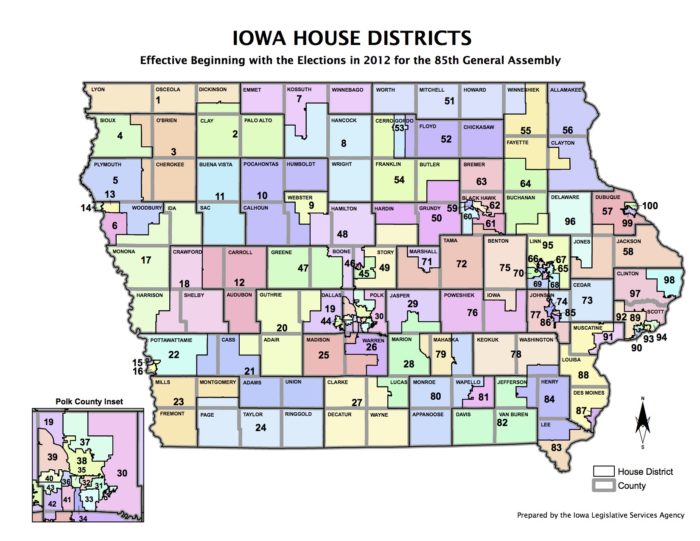
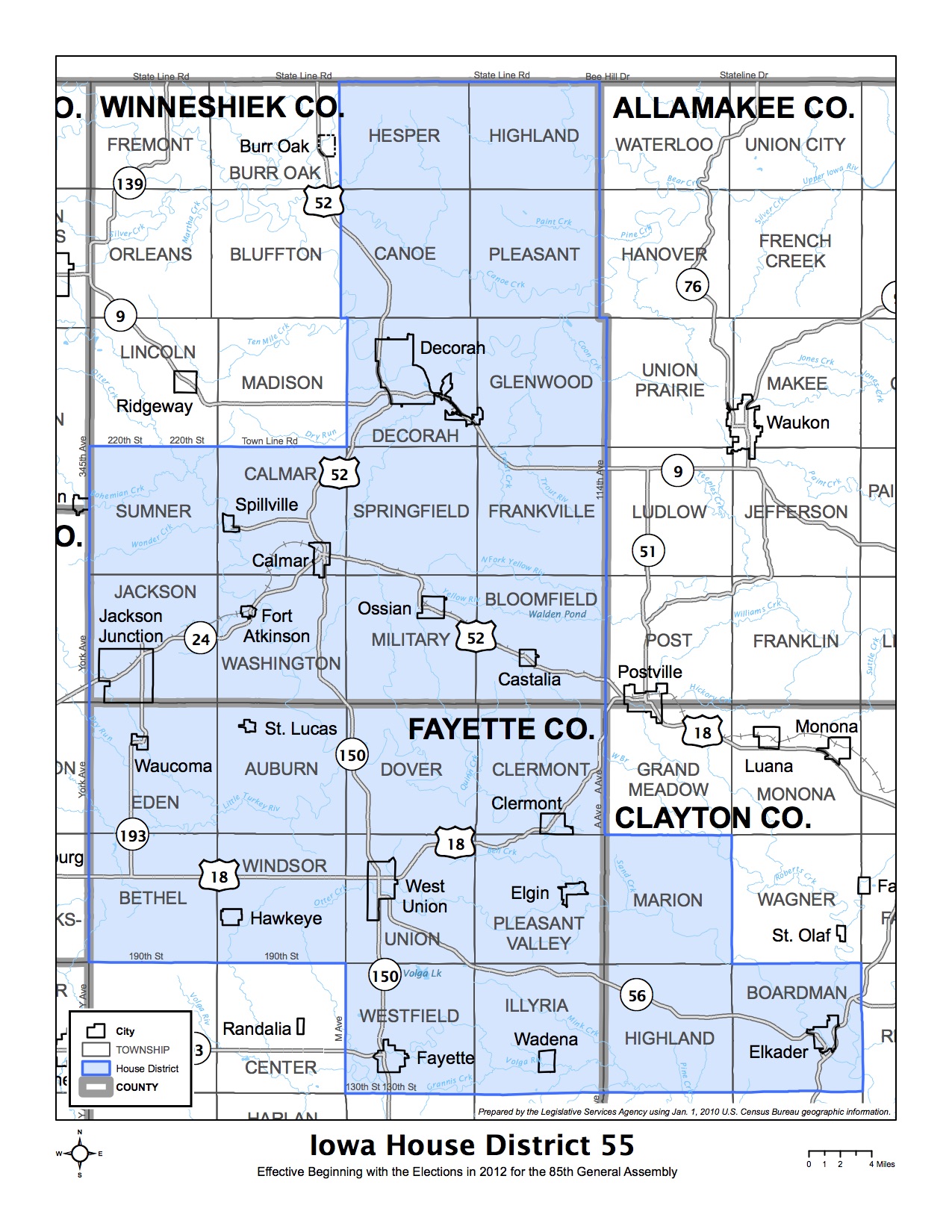
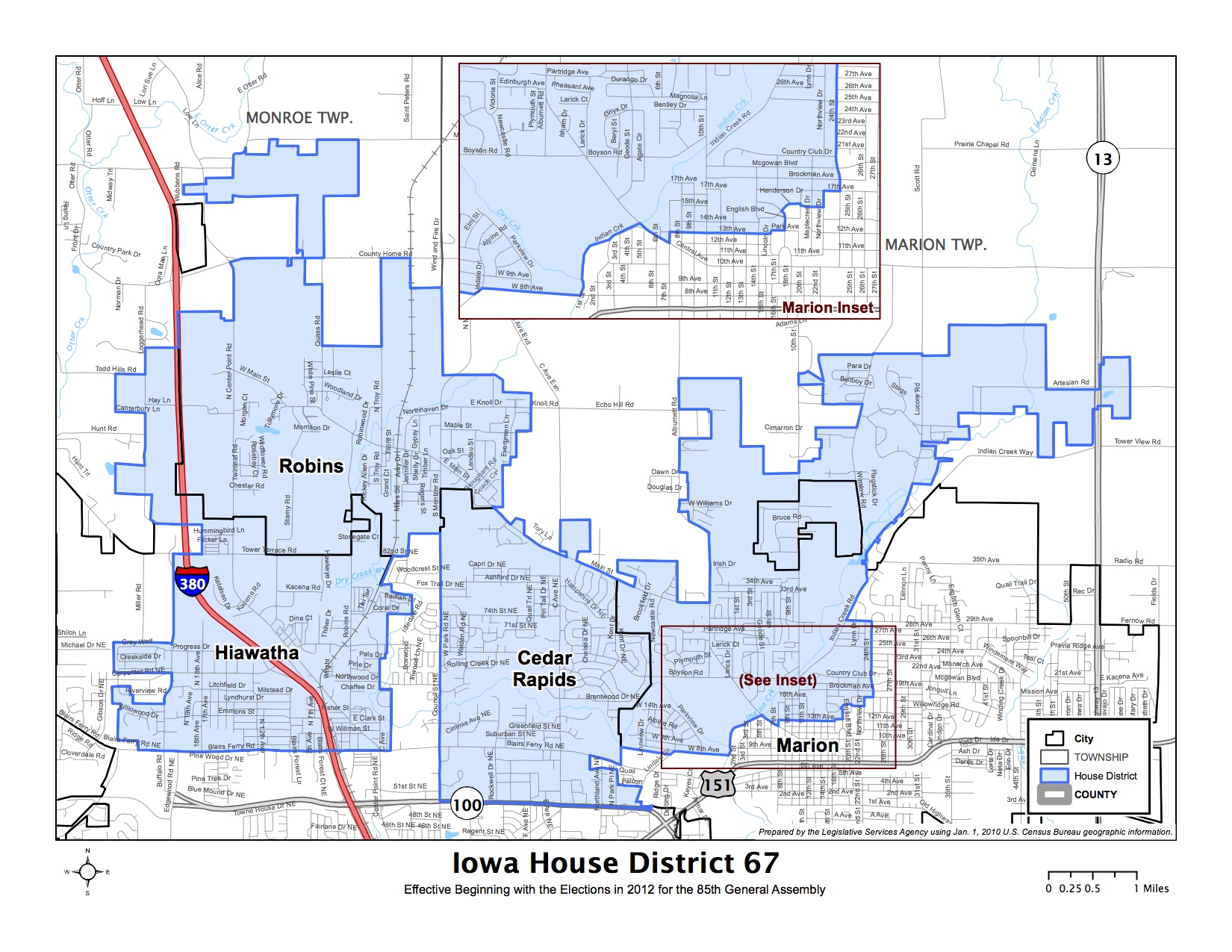
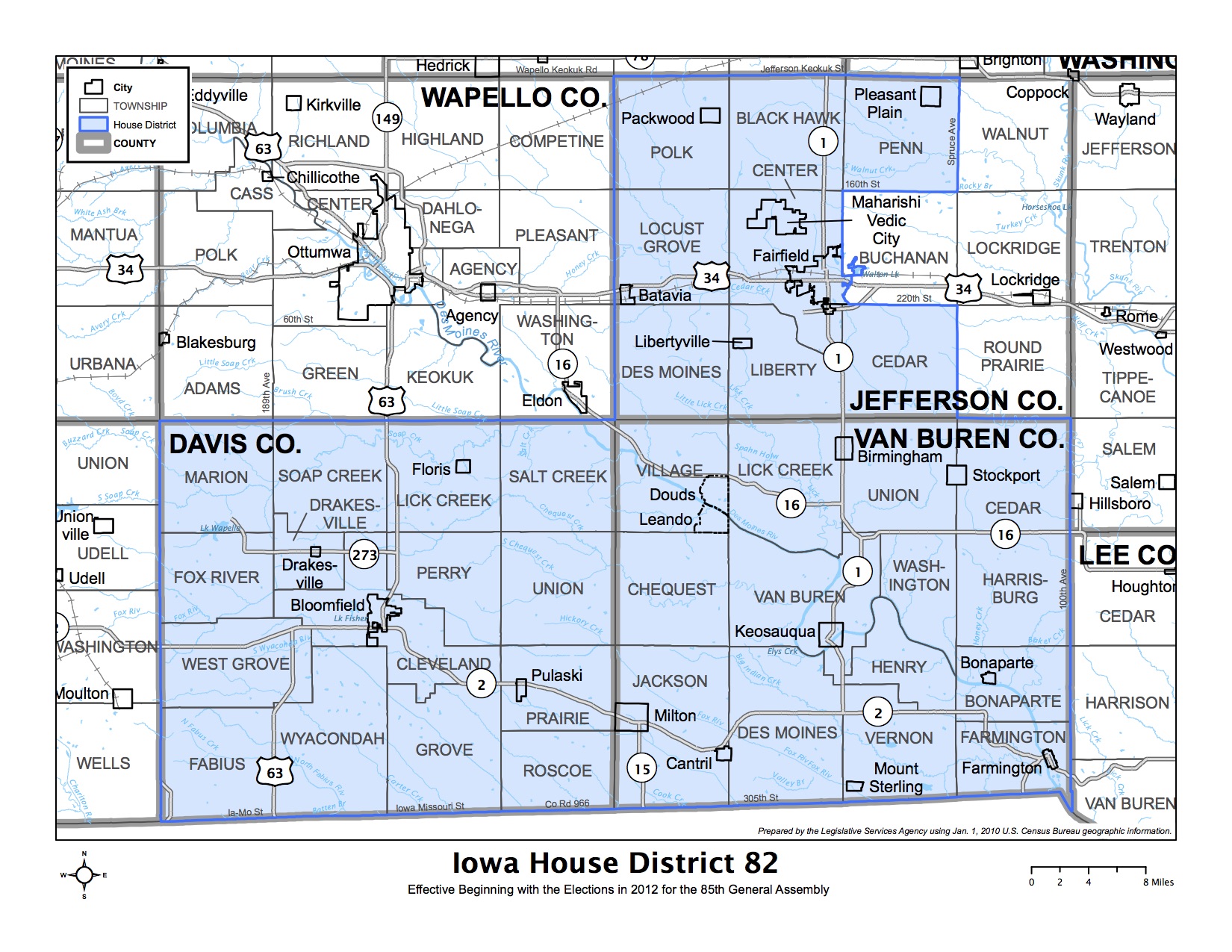
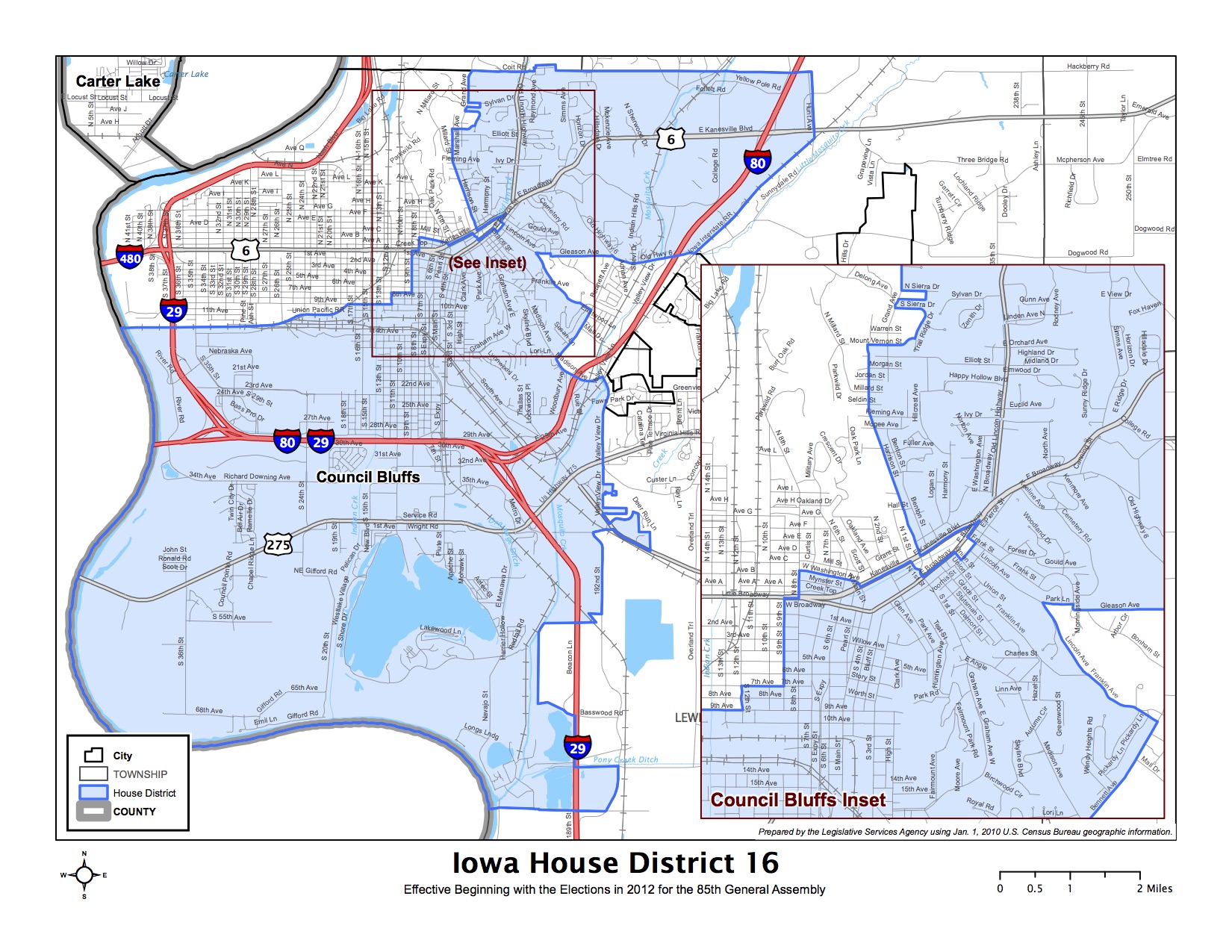
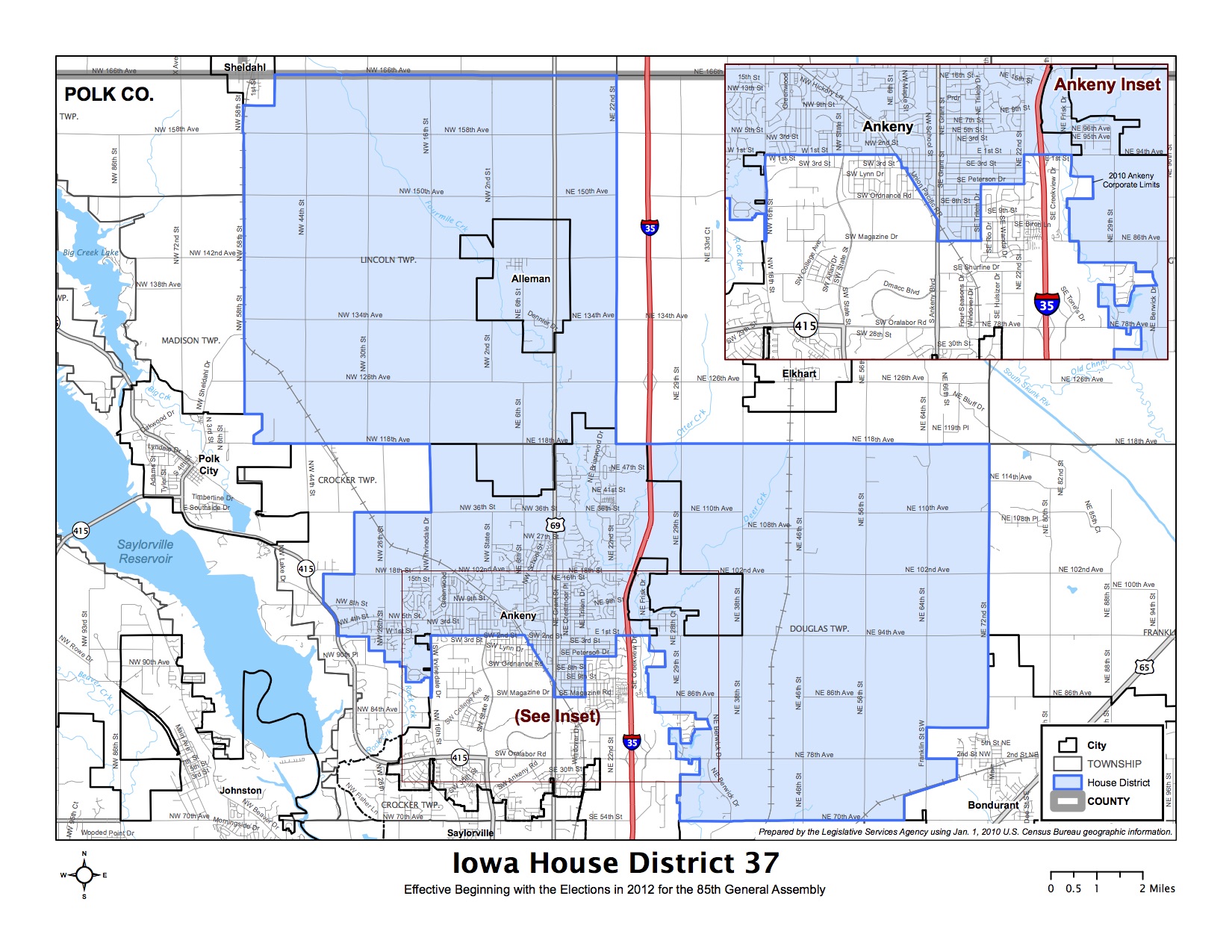
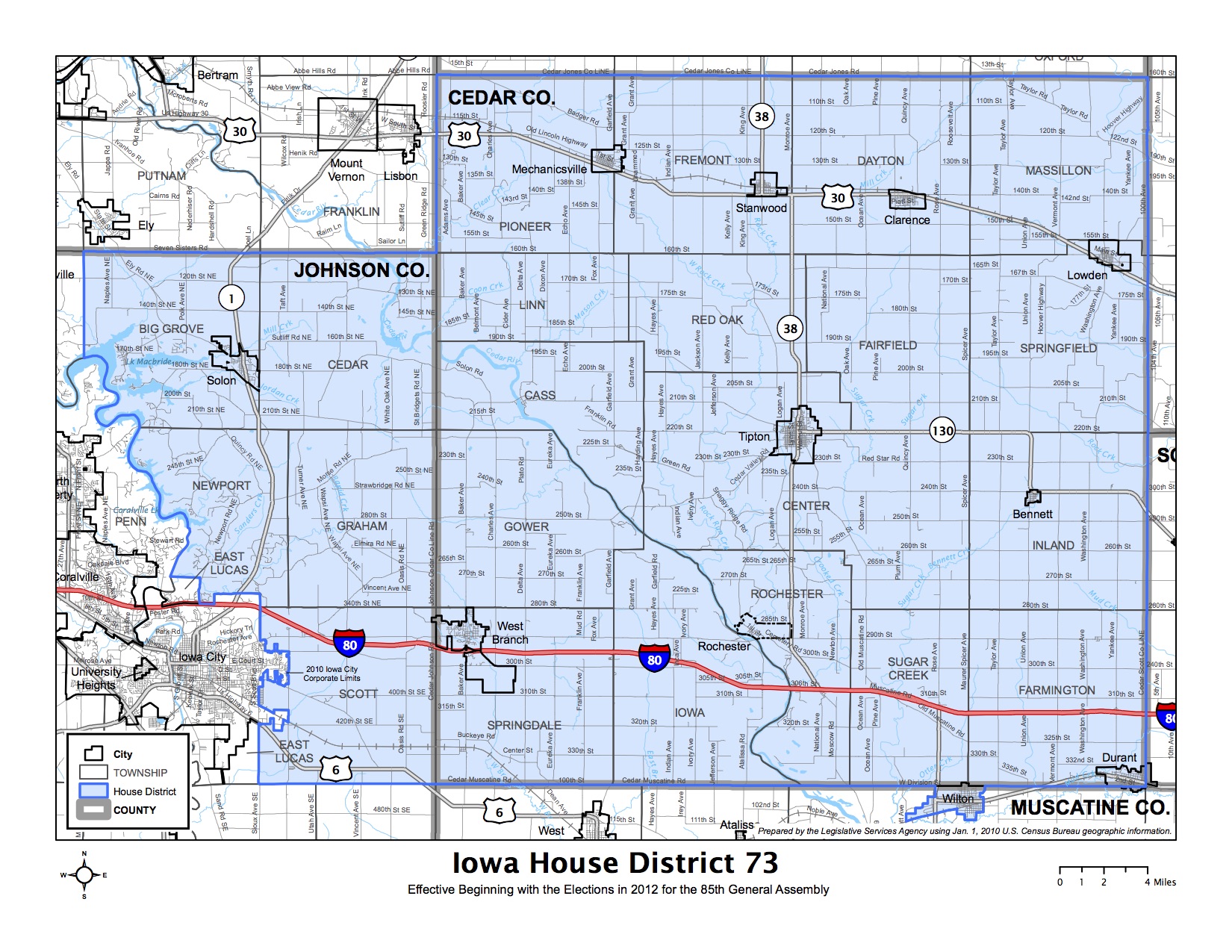
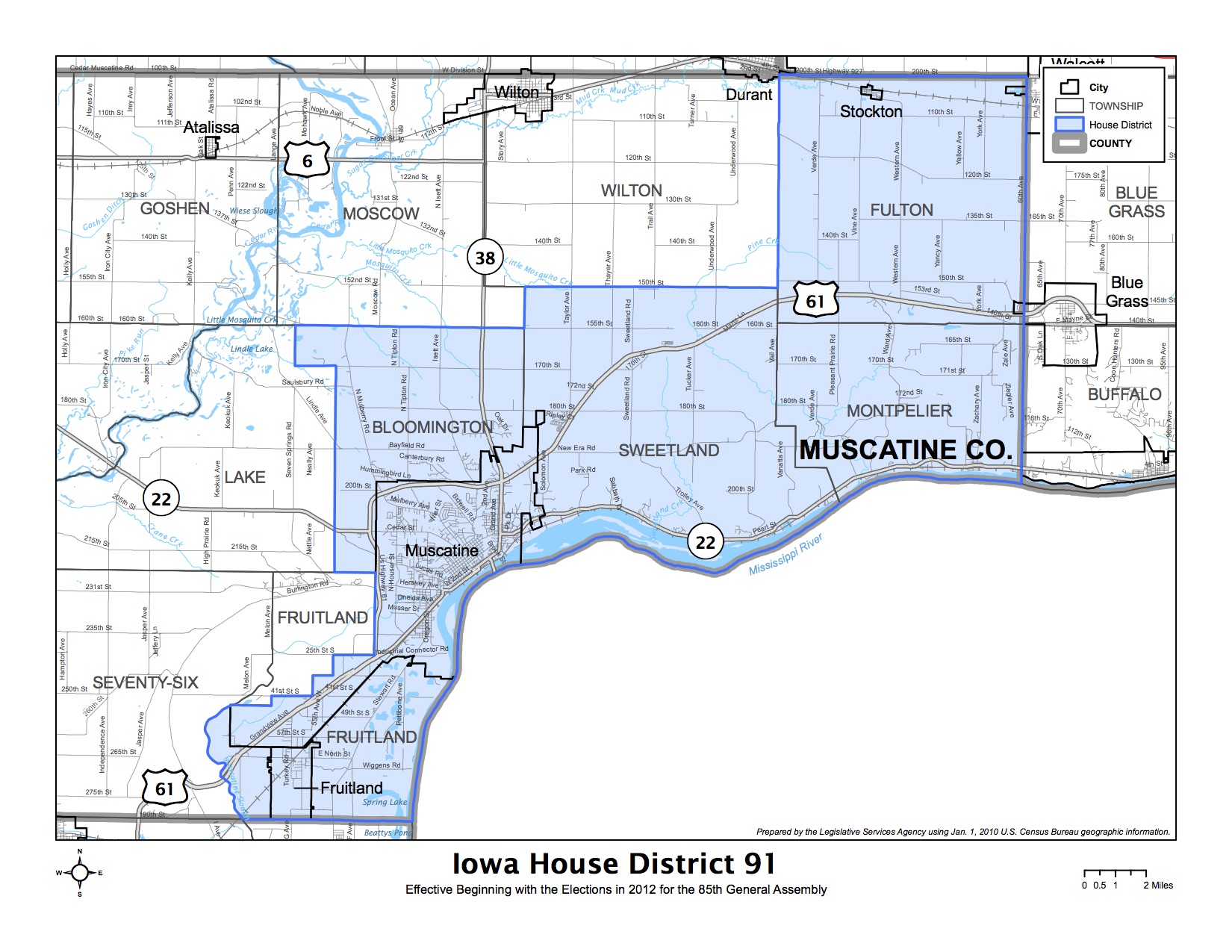
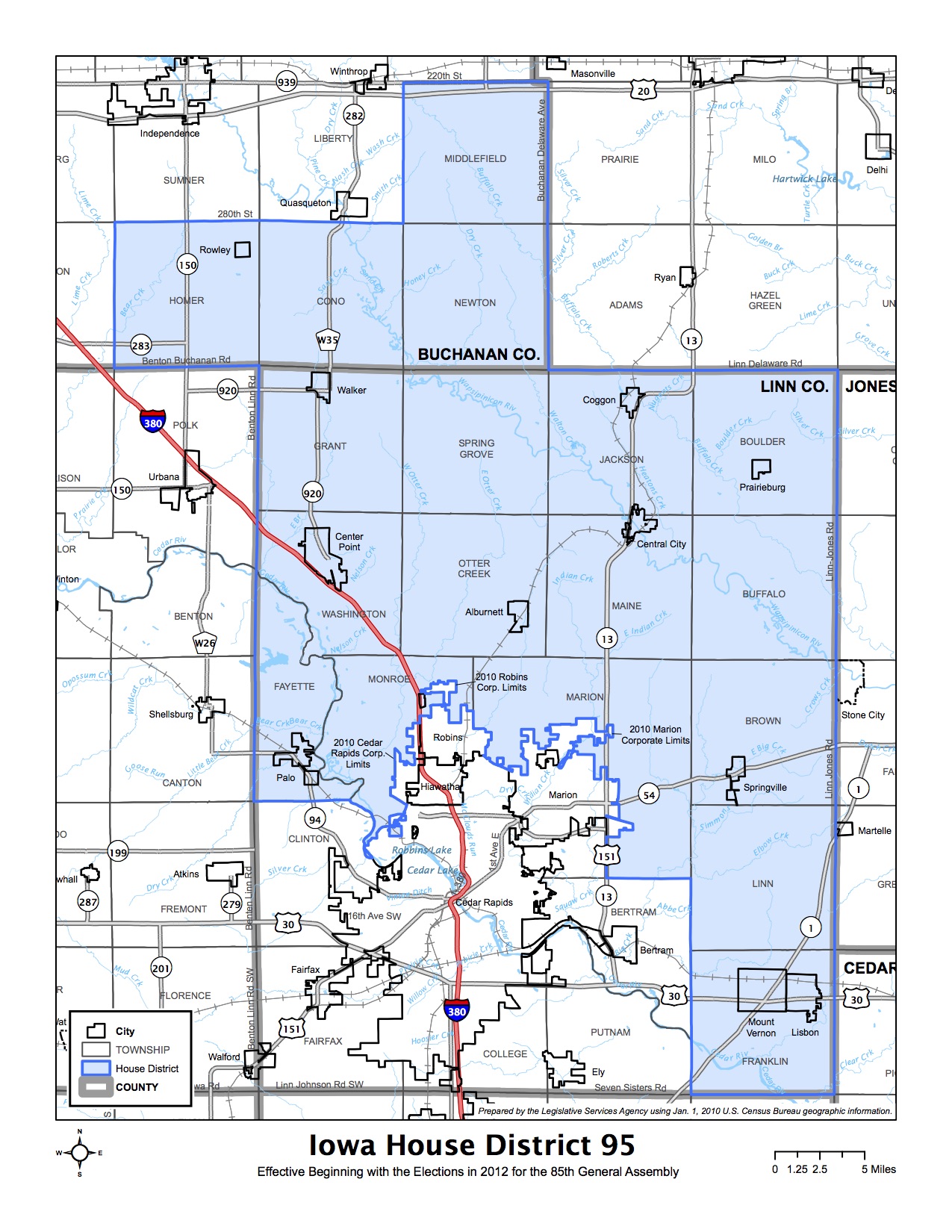
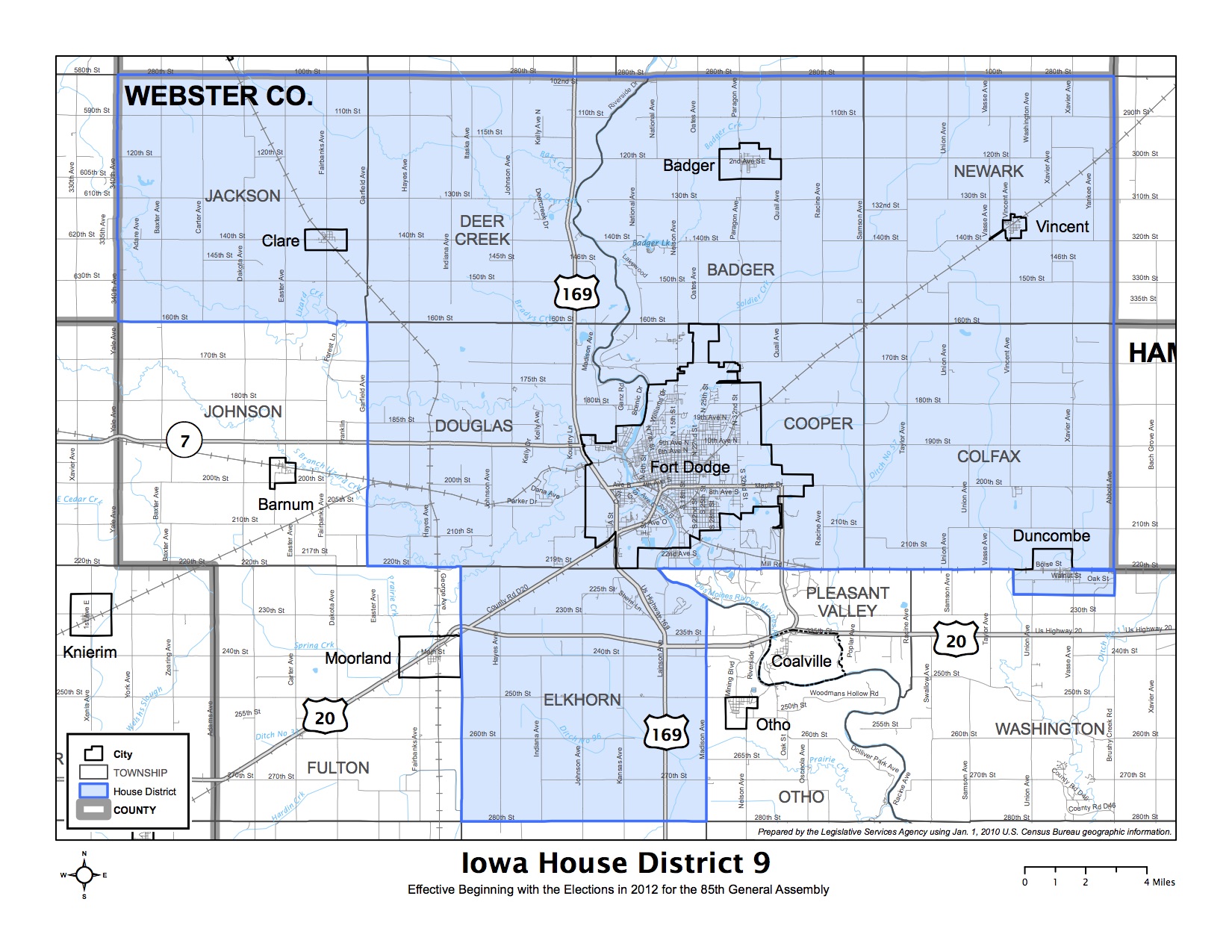
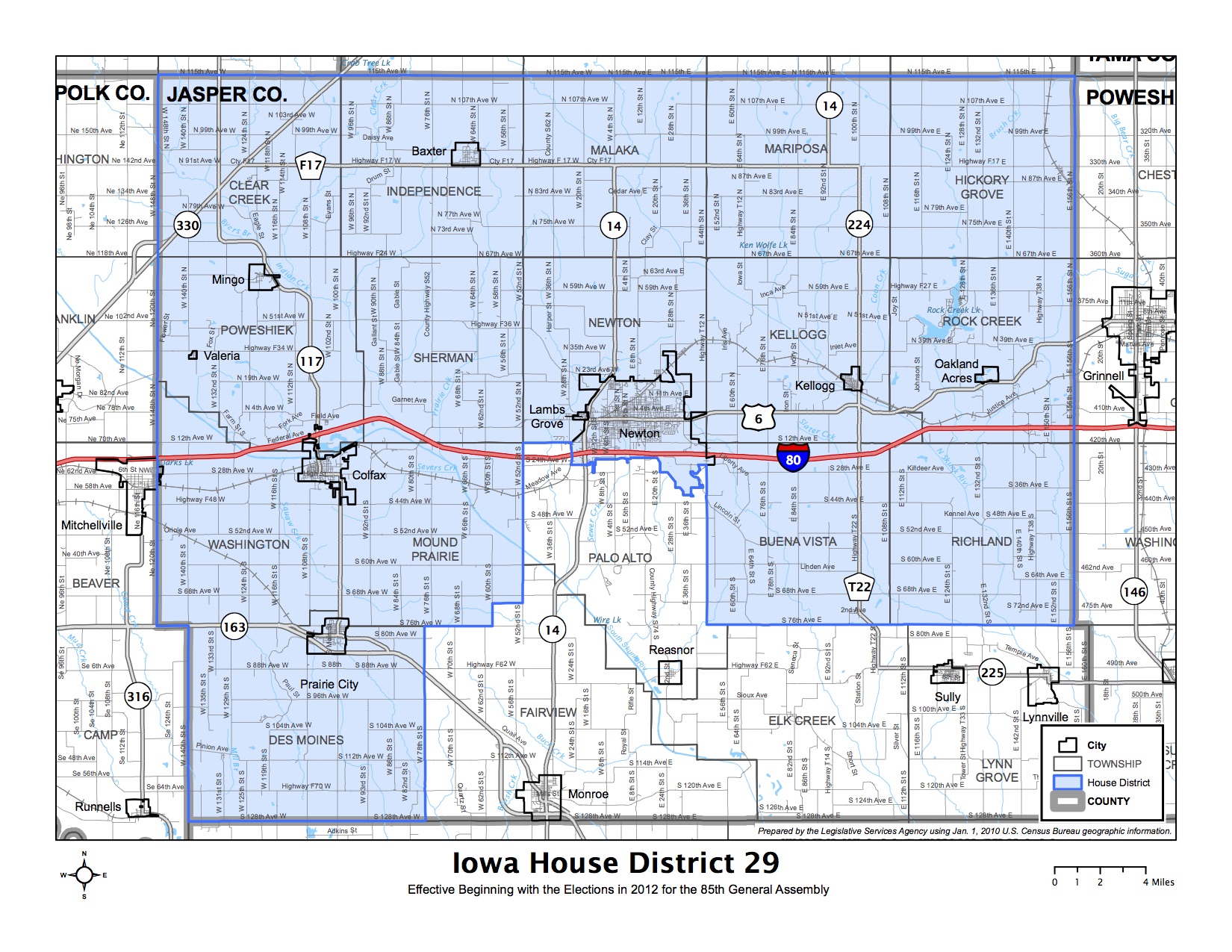
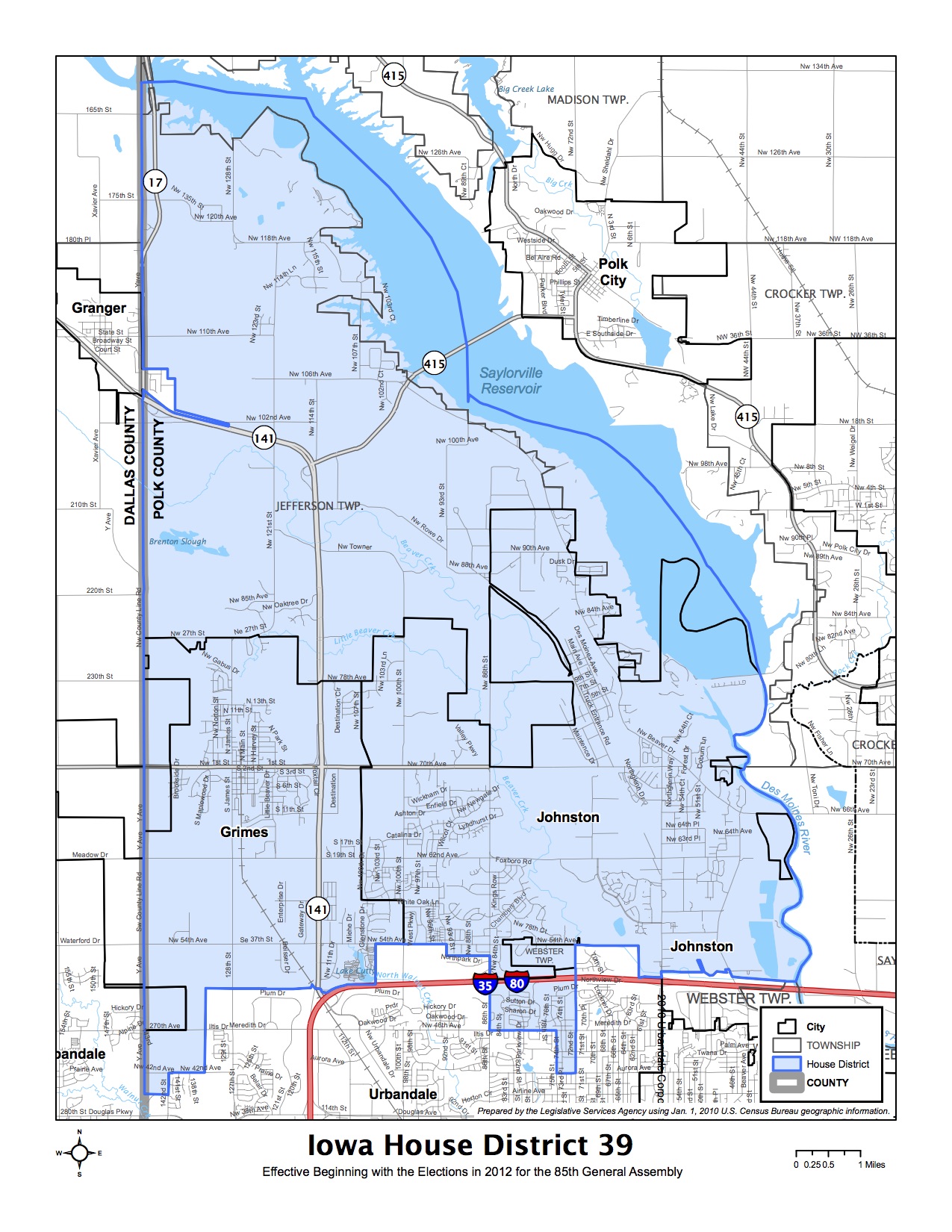
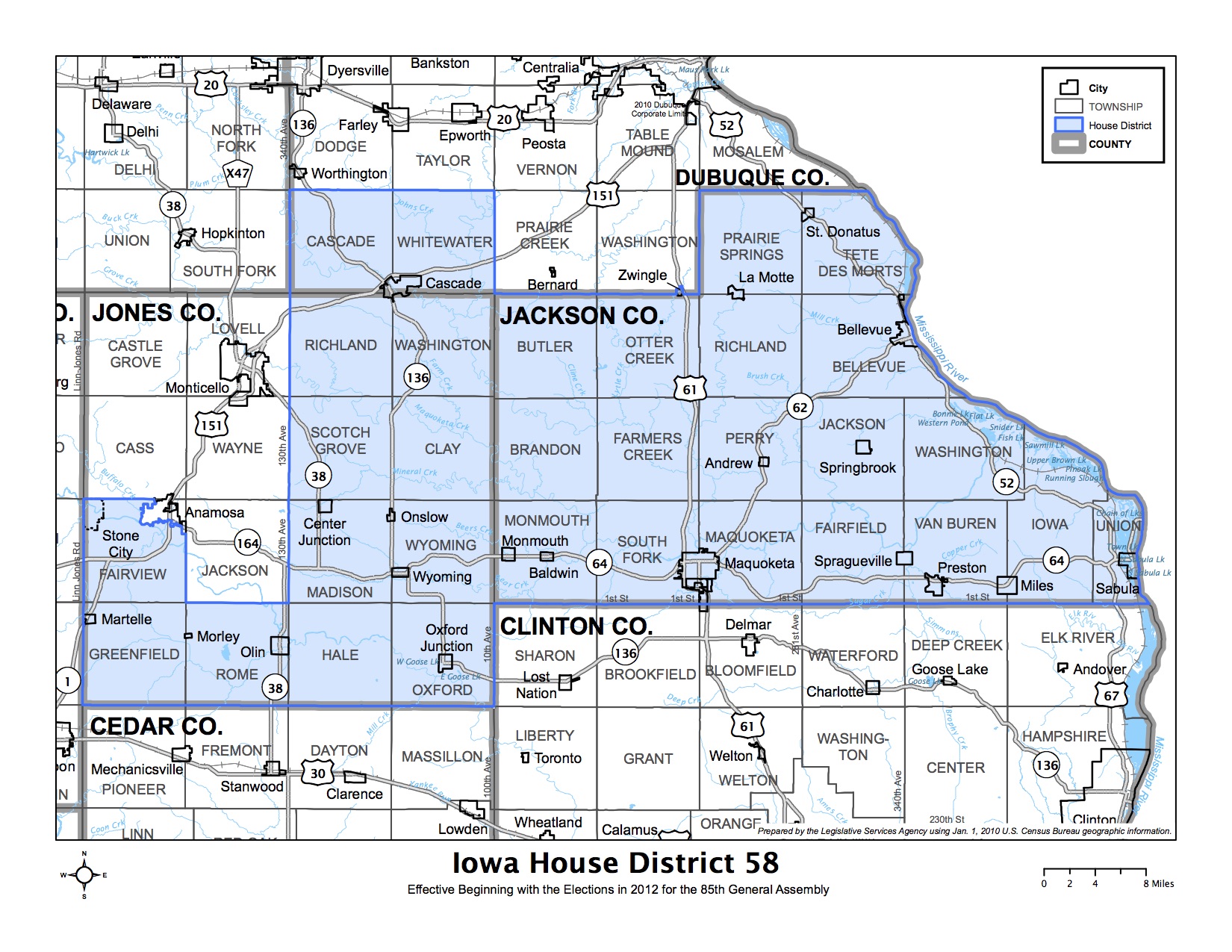
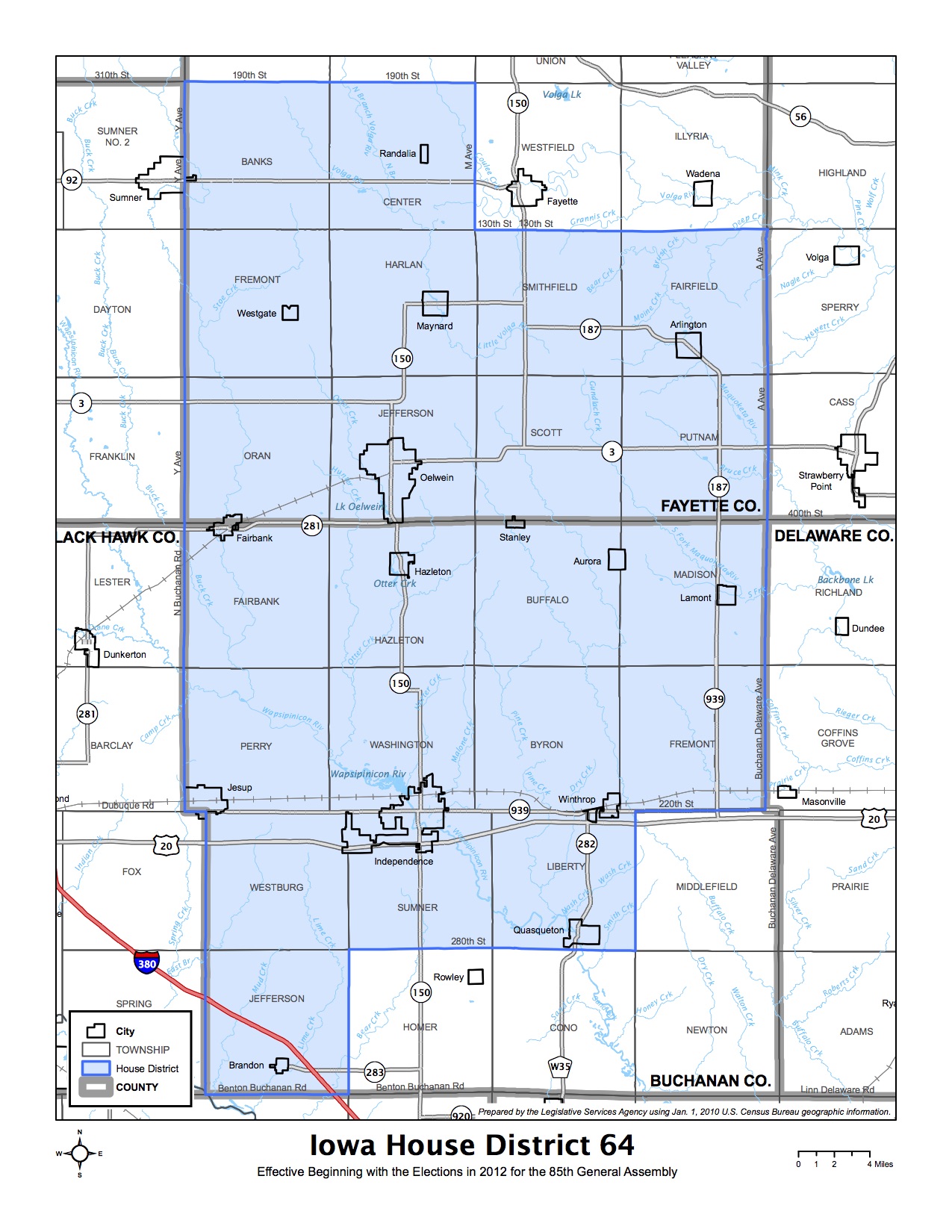
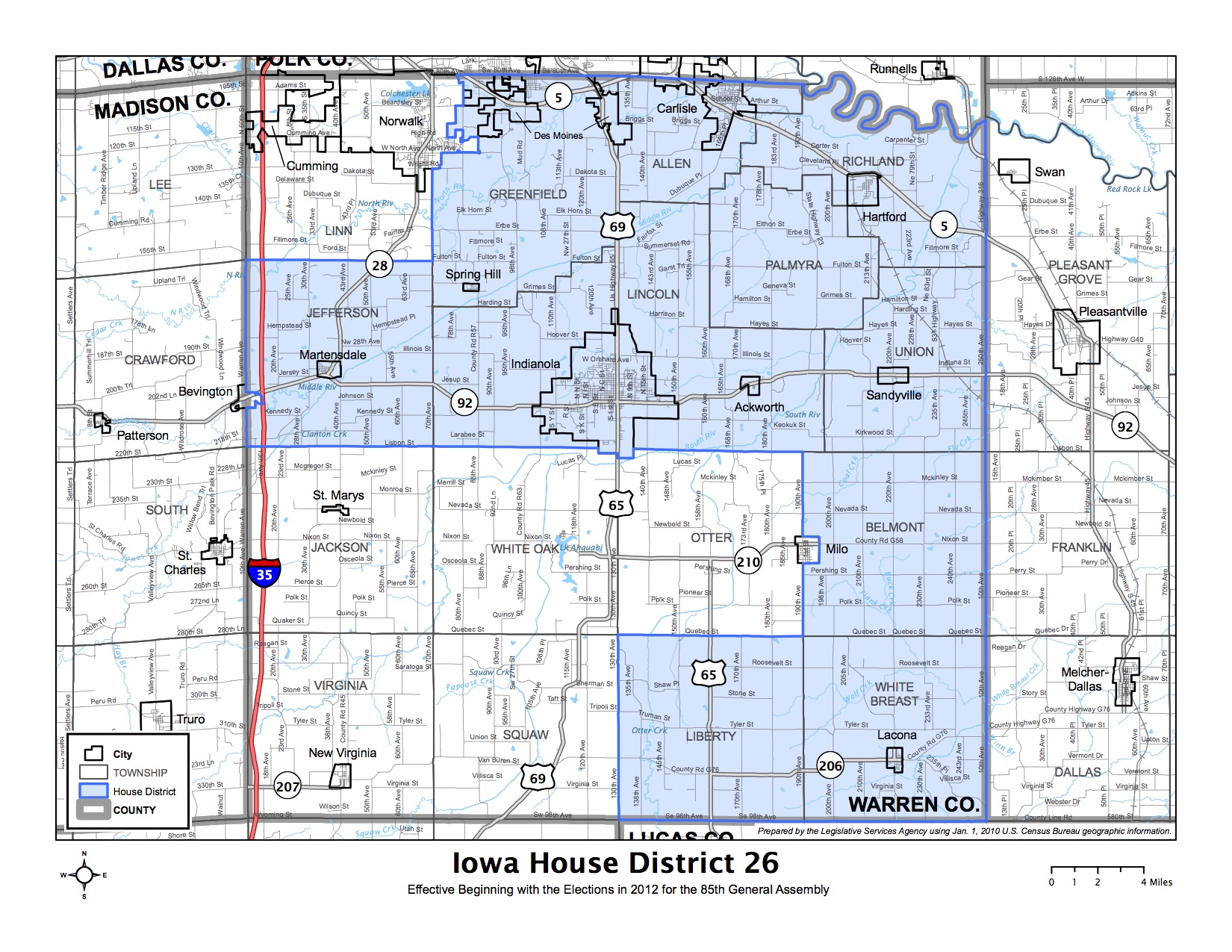
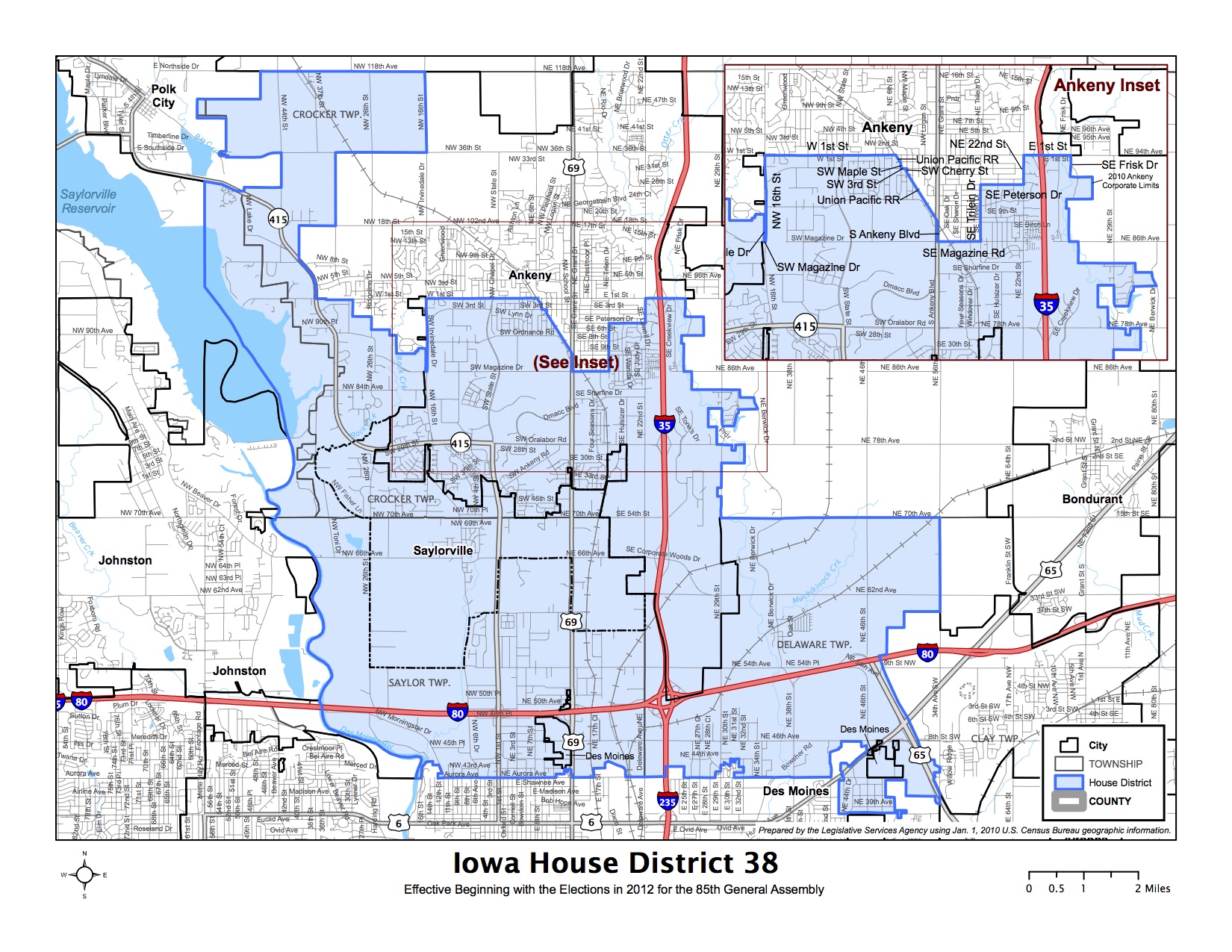
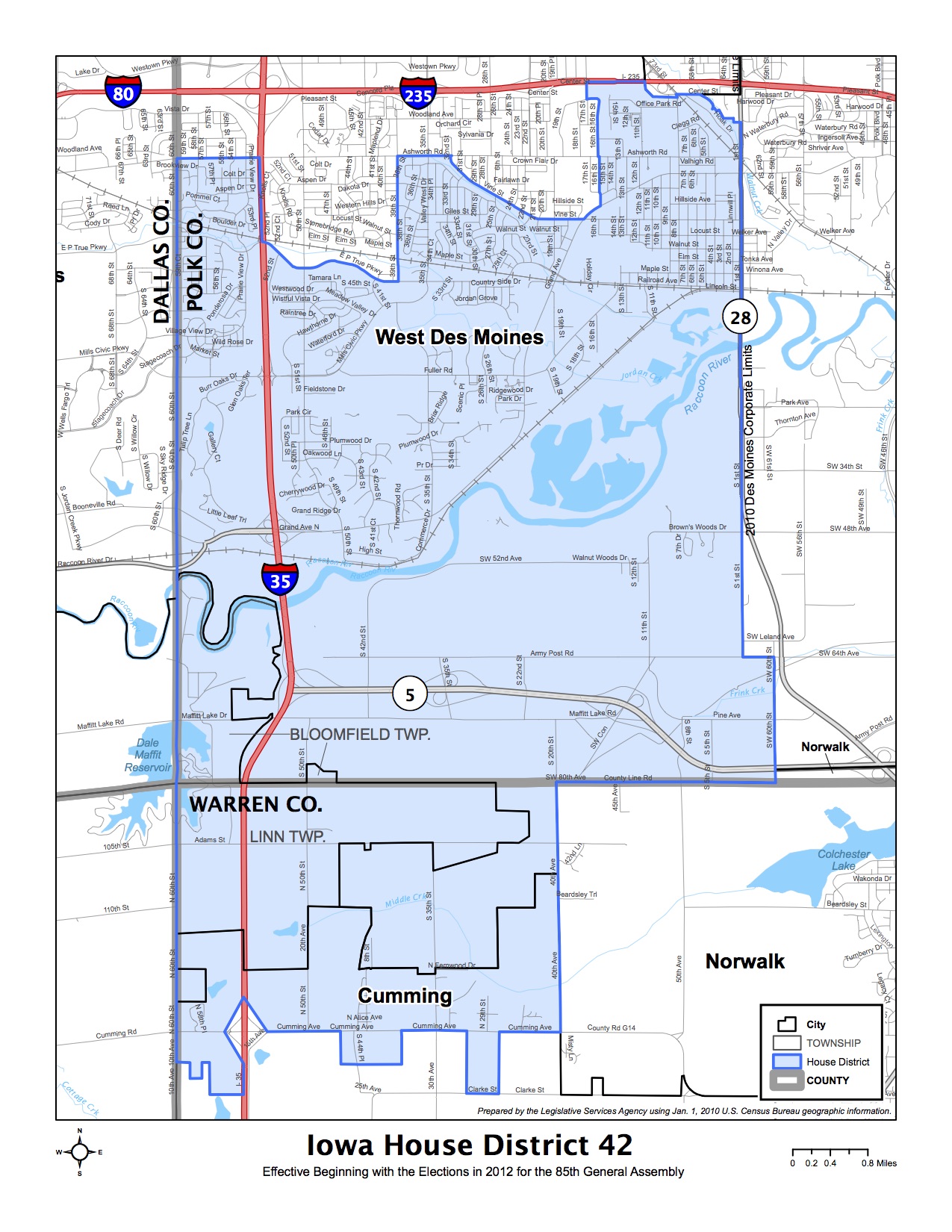
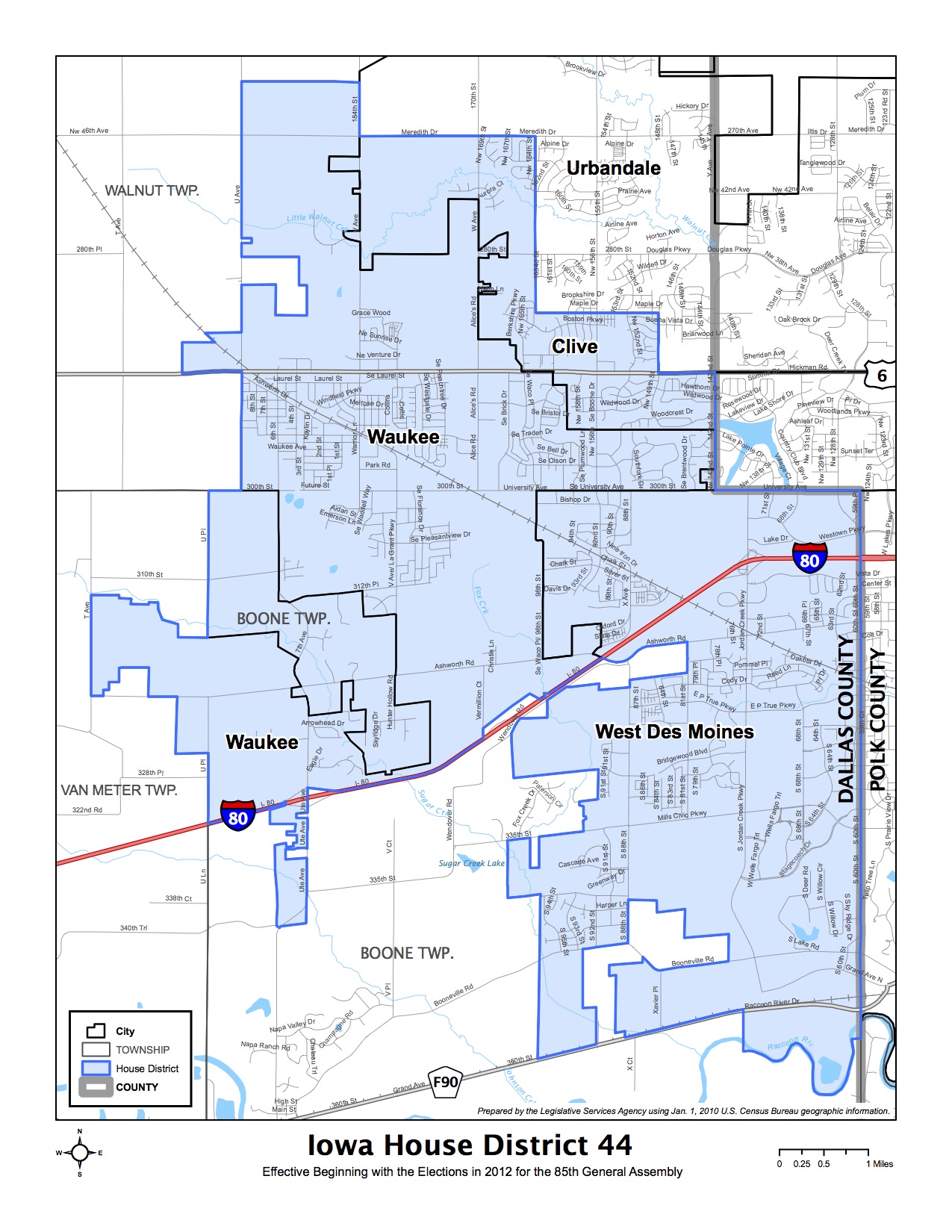
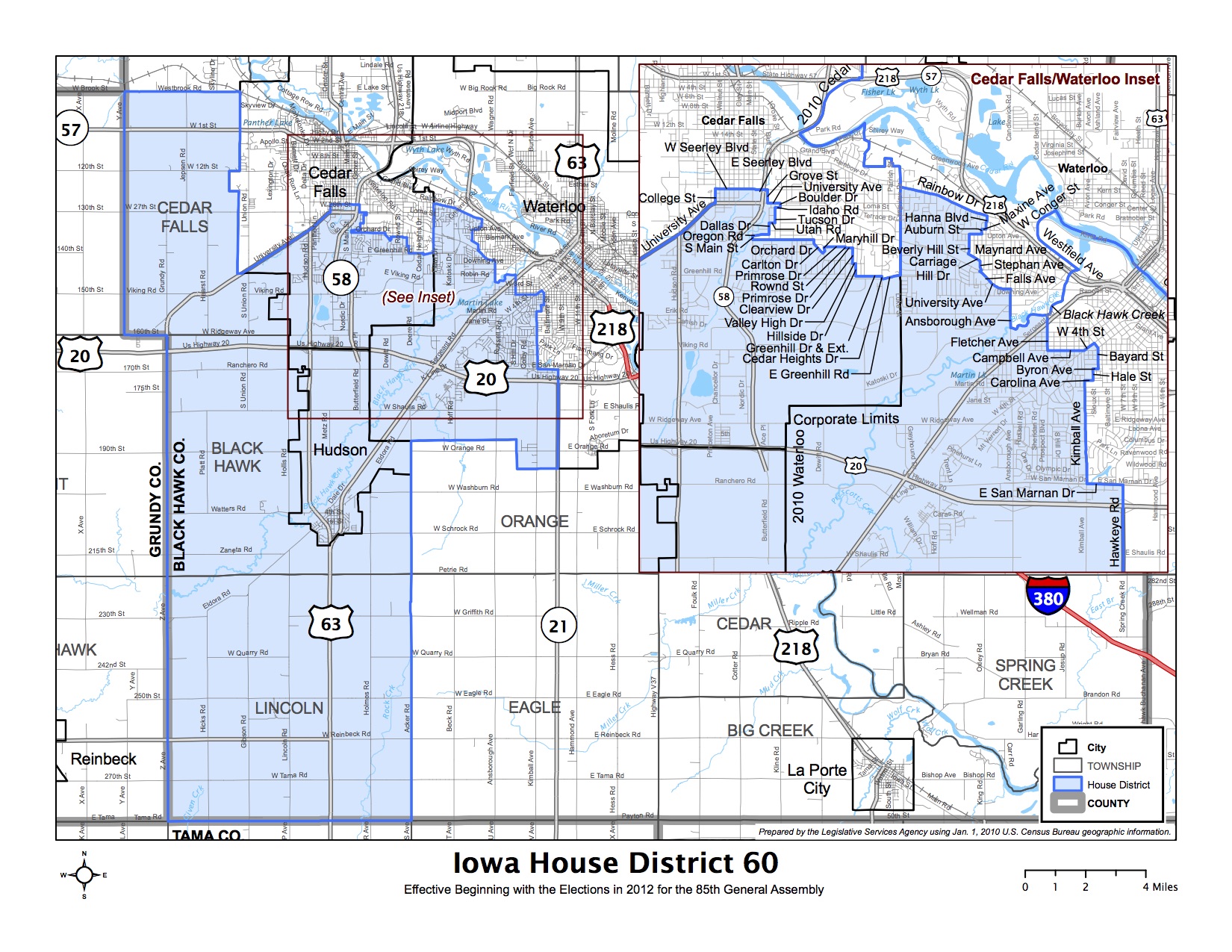
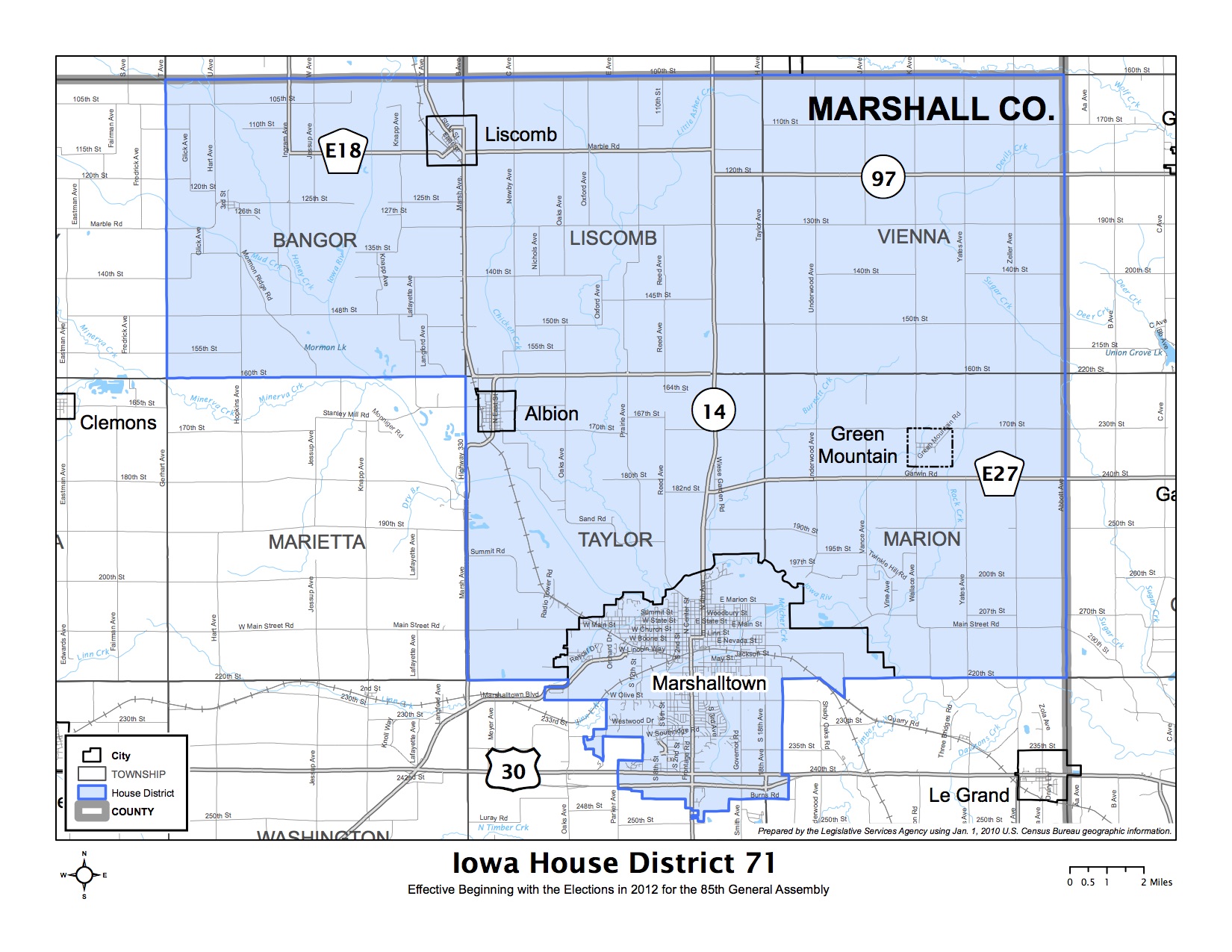
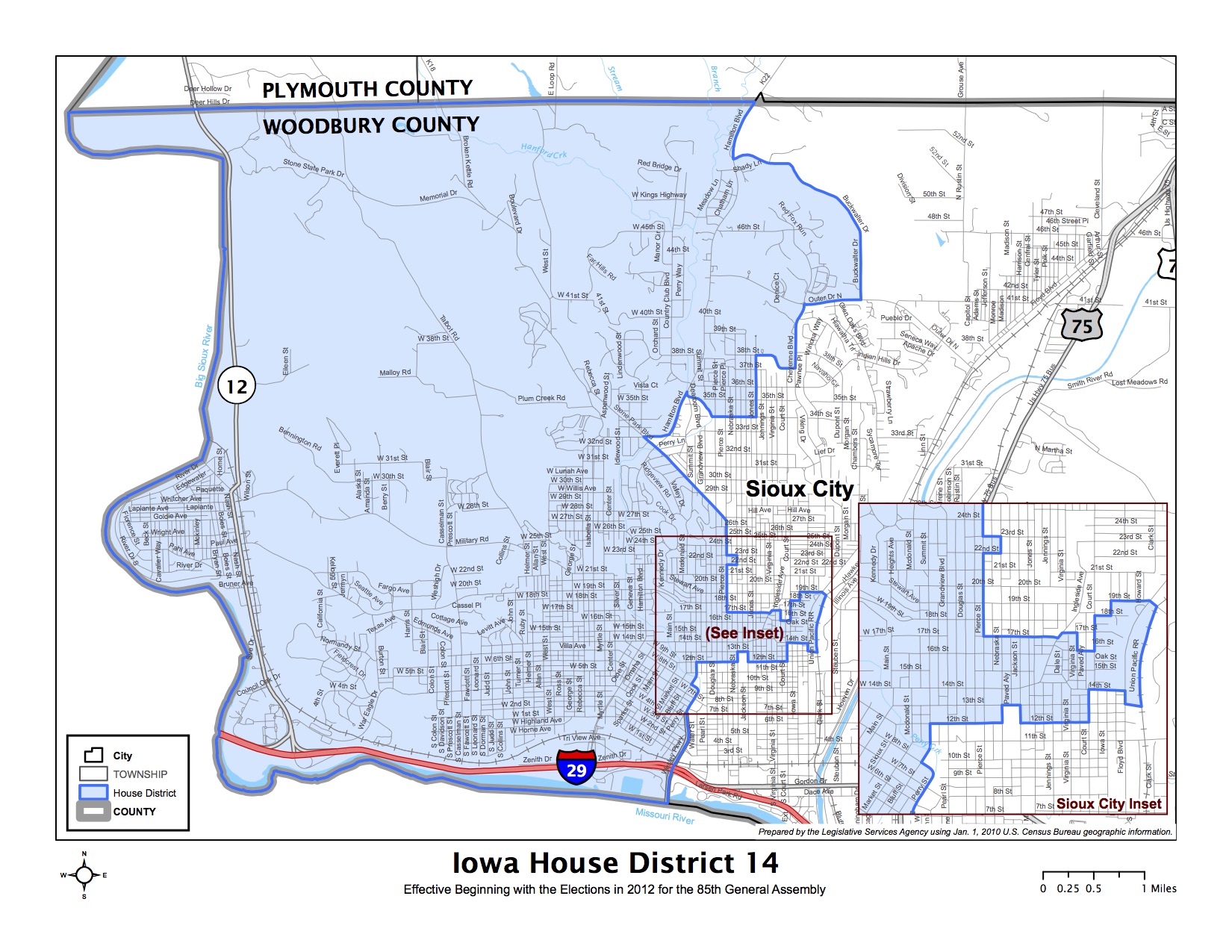
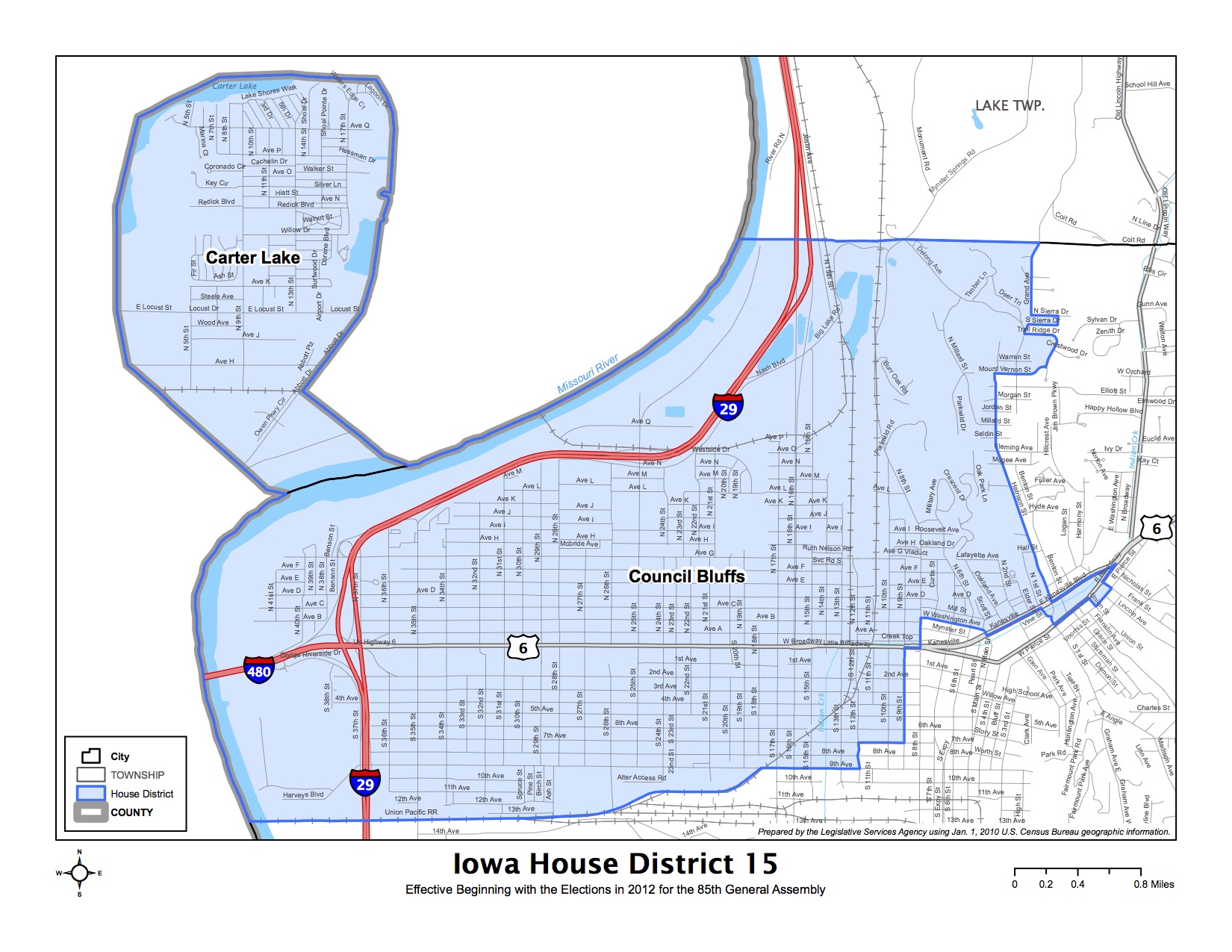
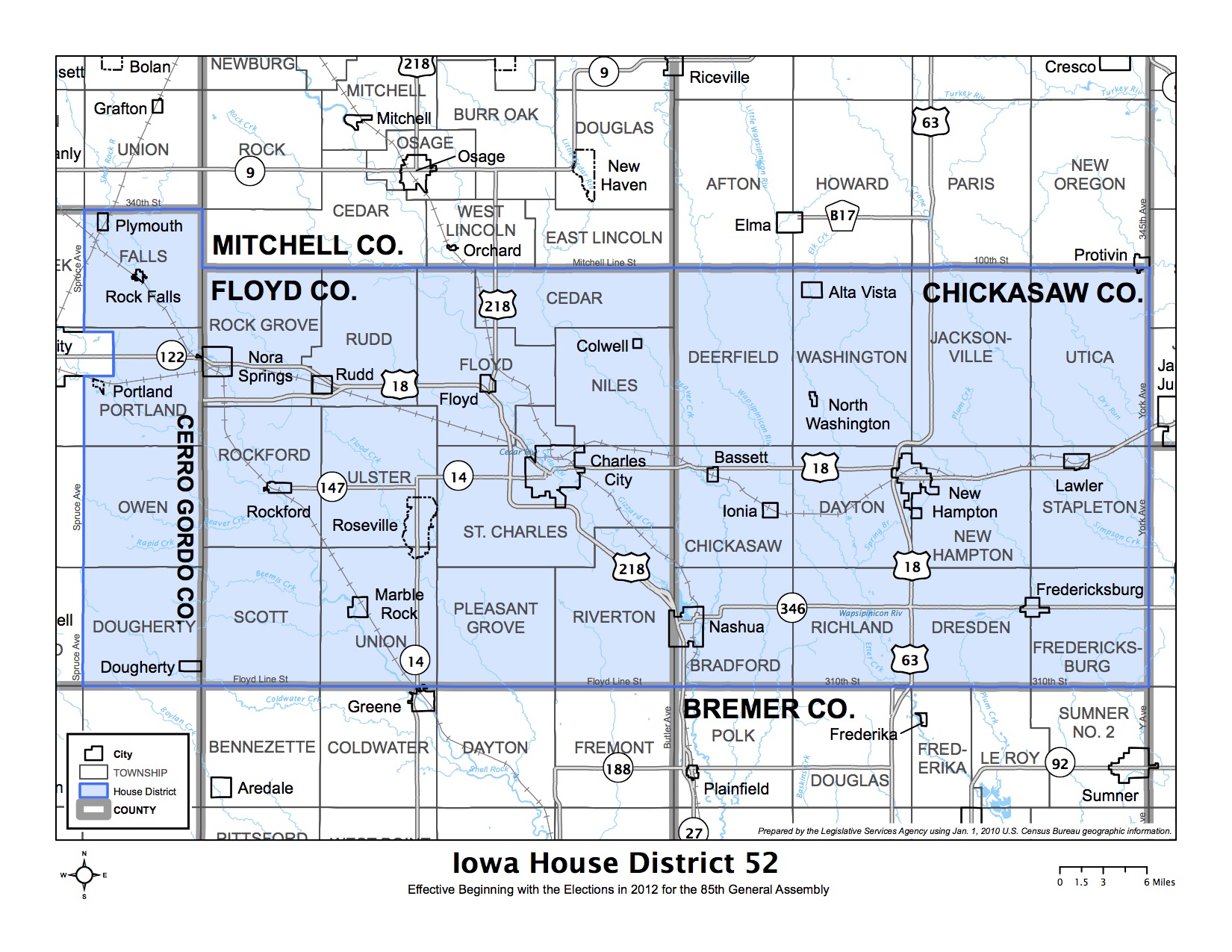
1 Comment
Thank you...
…this is extremely helpful and interesting.
PrairieFan Tue 17 Mar 1:53 PM